NAGEL, FREDERICK (or FREDRICH) (1835-1884). Private, 29th New York Infantry, Company C. Of German origin, Nagel enlisted at New York City as a private on May 9, 1861, and mustered into the 29th New York on June 4. According to his muster roll, he was paid $5.50 by the State of New York for his service from May 20 through June 4, 1861. He was discharged for disability on May 1, 1862, at Georgetown, Washington, D.C. On July 9, 1862, he applied for an invalid pension, application 1,456, but no certificate number is listed. The New York City Directories for 1874 and 1884 list his occupation as trimmer. As per the census of 1880, he lived in New York City with his wife and three children and worked as a carriage trimmer. His last residence was 2066 3rd Avenue in New York City. His death was caused by heart disease. Section D, lot 7078, grave 353.
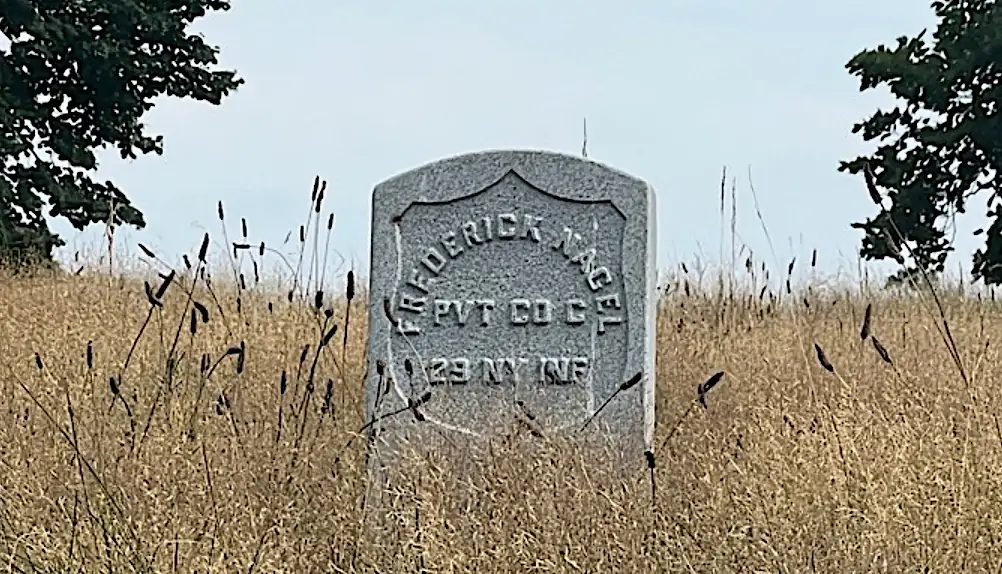
Civil War Bio Search
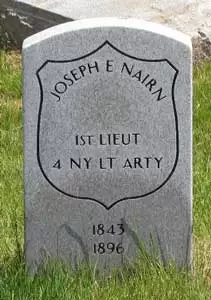
NAIRN, JOSEPH E. (1843-1896). First lieutenant, 4th New York Light Artillery. A native New Yorker, Nairn lived with his family in New York City in 1850. During the Civil War, he enlisted at New York City on August 20, 1861, and was commissioned into the 4th New York Light Artillery on October 15. During his service, he commanded the 4th Battery of Wainwright’s Brigade (see Charles Wainwright), Hooker’s Division, at the Battle of Fair Oaks, Virginia, May 31-June 1, 1862, and at the Seven Days’ Battle, Virginia, June 25-July 2, 1862. He also commanded the 4th, as part of Sickle’s Division, at the Battle of Fredericksburg, Virginia, December 11-15, 1862. On February 9, 1863, he was discharged.
The 1870 census reports that Nairn lived with his parents and siblings in New York City and worked in a public house; the 1875 New York City Directory lists him in the liquor business at 846 Eighth Avenue. The 1884 and 1886 New York City Directories report that he was in liquors at 831 Eighth Avenue; the 1891 and 1894 New York City Directories show that he was a bartender. His death certificate indicates that he was a widower who worked in the hotel industry. According to his obituary in the New York Herald, which referred to him as Lieutenant Nairn, survivors of the 4th Independent Battery were invited to attend his funeral. Nairn last resided at 46 West 45th Street in Manhattan. His death was attributed to cirrhosis. Section 135, lot 27263, grave 412.
NAIRN, WILLIAM RUTHERFORD (1836-1875). Corporal, 1st New York Engineers, Company L. Nairn enlisted as a private at New York City, his birthplace, on April 6, 1865, and mustered into the 1st New York Engineers on that day. He had two promotions, one to artificer, on May 1, 1865; the other to corporal, on June 12, 1865. Shortly after, on June 30, 1865, he mustered out at Richmond, Virginia. The 1868 and 1872 New York City Directories list him as a policeman. As per his death certificate, he was a bartender who died from chronic nephritis; however, his obituary in the New York Herald reports that he died suddenly of pneumonia. He last resided at 846 8th Avenue in Manhattan. Section 15, lot 17263, grave 1193.
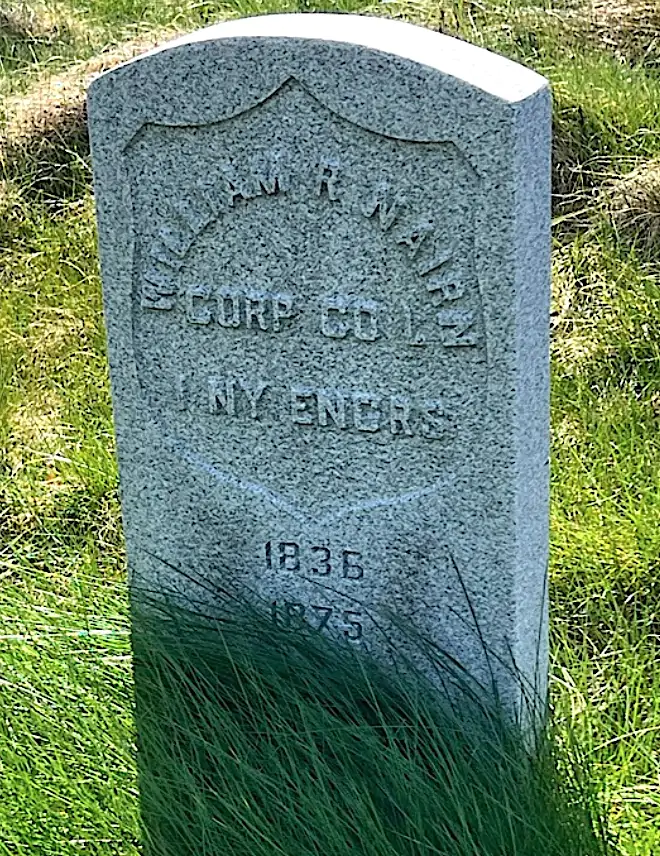
NAPIER, ROBERT (1829-1911). Private, 127th New York, Company C. Born in Belfast, Northern Ireland, Napier’s obituary in the Brooklyn Standard Union notes that he was educated at King’s College there. The New York Herald reports that he was a writer for the Belfast Daily Chronicle before he immigrated to the United States circa 1860. Although both obituaries list an immigration year circa 1860, Robert Napier’s name appears on the passenger list for the Franklin King which arrived from Liverpool in New York City on August 26, 1853; the 1900 and 1910 censuses confirm the immigration year as 1853. Napier appears in the 1855 New York State census as a straw merchant, in the New York City Directory for 1857 as a straw manufacturer, and in the 1860 census as a merchant living in New York City.
Although his obituaries do not indicate Civil War service, a Robert Napier, who is an age-match, enlisted on August 23, 1862, mustered into the 127th New York on September 8, and was listed as a deserter at Alexandria, Virginia, on February 13, 1863. Puzzlingly, that soldier’s muster roll, which lists a birthplace of England (not indicated on any other official document), reports that he was a machinist who was 5′ 5½” tall with gray eyes, brown hair and a dark complexion. The 1870 census reports that Napier was married with five children, lived in New York City, and worked as a traveling salesman. According to the 1880 census, he lived at 404 East 89th Street in Manhattan with his wife and extended family, and was a millinery goods merchant.
On October 14, 188o, Napier became a naturalized citizen; that document notes that he was employed in straw goods. His obituaries note that he was employed in the wholesale hat business on Wooster Street in Manhattan for many years. The census of 1900 notes that he lived in Brooklyn but was not working; at the time of his wife’s death in 1901 and in the 1904 Brooklyn Directory, his home address was 50 St. John’s Place. The 1910 census does not list an occupation for Napier. A widower with four surviving children at the time of his death, he last lived at 50 St. John’s Place in Brooklyn. His death was attributed to heart disease. Section 125, lot 23798.
NASH, FRANCIS E. (1835-1889). Private, 79th New York Infantry, Company I. As per the 1850 census, Nash was born in New York, lived in New York City with his step-father, and worked as a composition writer; the 1855 New York State census lists him as a composition maker. After enlisting at New York City on May 13, 1861, he mustered into the 79th New York on May 28. As per his muster roll, Nash was arrested as a deserter and his pay of $10.00 was stopped. His muster roll goes on to note that by order of the General Court Martial of February 1864, all pay and allowances were to be stopped until May 1864 and he was to be transferred to another regiment at ½ pay. No other regiment is listed on that muster roll but it is written that he was to get no pay or allowances until the expiration of his term; his June 1864 muster roll notes that he was sentenced to serve six months as of May 1864. His muster roll for December 1864, which notes that he mustered out on November 12, 1864, indicates that he was wounded at Fredericksburg, Virginia (no date given), and hospitalized.
In 1870, his application for an invalid pension was approved, certificate 126,583. The 1870 census reports that he was married with young children, lived in Manhattan, and worked as a frame decorator. The 1880 census and the 1887 Brooklyn Directory list him as a decorator; he lived in Manhattan in 1880 but the Brooklyn Directory lists his home address as 176 Division Avenue. As per his death certificate, he was married and was employed as a wood-turner. His last address was 176 Division Avenue in Brooklyn. Section 180, lot 13574.
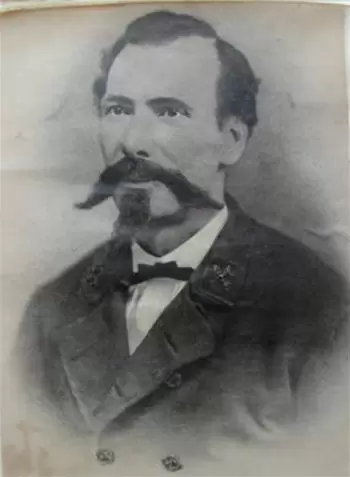
NASH, WILLIAM HENRY (1832-1875). Captain, 1st Regiment, United States Sharpshooters, Companies B and K. A New York City native, Nash was educated in the public schools. As per Reminiscences of the Old Fire Laddies by J. Frank Kernan (1886), he learned the trade of gilder. However, he turned to the military in 1852 when he enlisted as a private in the United States Army and served in Battery B of the 3rd Artillery and then served in California. In 1853, he volunteered to carry mail over 135 miles during the Comanche Indian war, a hazardous journey that he undertook alone. After a promotion to sergeant, he fought in the Indian Wars in Oregon, took a bullet to his spine, and recovered despite being left for dead and given an ominous prognosis.
During the Civil War, Nash served in Companies B and K of the 1st Sharpshooters, also known as Berdan’s Sharpshooters, Regular Army, as a first lieutenant and then as a captain. The 1st Sharpshooters were attached to the Army of the Potomac, 3rd Army Corps. As per his muster roll, he enlisted as a first lieutenant on March 6, 1862, at Washington, D.C., and was commissioned into Company B of the 1st Sharpshooters two days later. His sketch in the Reminiscences of the Old Fire Laddies notes that Nash was praised for gallantry in the Seven Days’ Battles (June 25-July 1, 1862) when he led his regiment across Kelley’s Ford, being the first to cross the river under heavy gunfire. Nash was transferred to Company K on January 10, 1863, upon his promotion to captain. He was mentioned by Colonel Hiram Berdan, who commanded the Sharpshooters, after the Battle of Gettysburg, Pennsylvania: “I desire to make special mention of Capt. Nash, who rendered invaluable assistance to the reconnaissance referred to and behaved most gallantly.” He was also mentioned by name in Victory Without Triumph, on page 156, as being one of three officers from the 1st Sharpshooters who were leaning against a tree at the Wilderness on May 6-7, 1864, when a lone Confederate round struck the tree; Nash and other captain ducked while the lieutenant stood still and all escaped injury. However, he apparently was captured that day, was listed as missing on the muster roll and was imprisoned at Macon, Georgia, until his name appeared on the muster roll as present on August 31, 1864; his sketch in Reminiscences of the Old Fire Laddies incorrectly lists the date of capture as May 5, 1863.
As per a sketch on GenDisasters.com, Nash was appointed a member of the New York City Fire Department on July 23, 1868, and assigned to Engine Company No. 7. On November 14, 1868, he was appointed assistant foreman of Engine Company No. 28 and appointed foreman of that company three months later. In August 1870, he was transferred to Engine Company No. 8, became Chief of the Eighth Battalion in January 1872, and then transferred to the Fourth Battalion. That sketch describes him as being six feet tall, erect and with a “military air.” As per the New York City Directory for 1870 and the 1870 census, Nash lived with his wife and children on East 54th Street in Manhattan and was a fireman. Nash was considered for the Bronze Bennett Medal, the highest award for valor given to firefighters, for his actions on December 30, 1872, when he responded to a call at 223 Division Street. At that address, without protection of a hose-line, he made his way to a rear bedroom where he saved two children who were trapped by the flames. For his actions, he was placed on the Roll of Merit in 1873. His obituary in the New York Tribune, which confirms his Civil War service, notes that he received the Fire Department bronze medal for gallantry and that he saved numerous people at fires; his sketch in the Reminiscences of the Old Fire Laddies also notes that award.
Nash died in a tragic accident. As per The Last Alarm by Boucher, Urbanowicz and Melahn, on September 14, 1875, Battalion Chief Nash and a detail of his men were assigned to demonstrate a new aerial ladder. Nash had tested the ladder early in the morning to make sure it was safe. He and his men were to show the aerial ladder to the public at about 11:00 a.m. at the junction of East Broadway and Canal Streets. The area was crowded with spectators and they were pushed back from the ladder by the police to prevent injury in case of an accident. When Nash reached the top of the ladder, 98 feet up, followed closely by two other firefighters, a loud snapping sound was heard, the ladder broke, apparently as a result of weak wood, and the three men fell to the pavement below; Nash and one fireman died instantly, the third died shortly after the three bodies were brought to the Madison Street police station. Five other firemen, who were below them on the ladder, were uninjured in the accident. The crowd was aghast at the sight of the sudden disaster. The sketch in Reminiscences of the Old Fire Laddies indicates that the process of putting the Scott-Uda Ladder into operation was mired in corruption and mismanagement. Mrs. Uda (neé Scott), who owned the patent to the ladder for which she was paid $25,000 by the Fire Department and was looked upon with mistrust, was present at the accident scene along with the secretary of the Fire Department. As per the reminiscence, the ladder, one of four, was built of light pine timber at Concord, New Hampshire, by the Abbott Downing Company at a cost of $2,000 per ladder.
As per his death certificate, he was married and was the Chief of Fire Battalion #4 of the New York City Fire Department at the time of his tragic death in Manhattan on September 14, 1875. As per an article about his funeral in The New York Times on September 18, 1876, Nash, the Chief of Fire Battalion No. 4, was the last of the victims of aerial ladder tragedy to be buried. Nash’s funeral took place at the Seventh Presbyterian Church on the corner of Broome and Ridge Streets. Six firemen bore his rosewood casket on their shoulders and entered the church, draped in mourning and filled with floral tributes. The church was crowded with friends and relatives, colleagues and delegations from organizations of which he was a member; spectators filled the street outside. Nash was dressed in his firefighter’s uniform. Among the organizations sending delegations and following a procession of sixty-five firemen to Green-Wood for burial were the Freemasons, the Third Army Corps Union, Knights Templar, the Odd Fellows, Company C of the 22nd Regiment and a contingent from the Grand Army of the Republic. The procession had a police escort led by Inspector George W. Dilks (see). The flags at City Hall were at half-mast and a coroner’s inquest into the tragedy was scheduled. Members of the Fourth Battalion wore badges of mourning for 30 days after his death and sent resolutions of condolence to his family, citing their appreciation for his stern discipline, faithful service, noble instincts and gentlemanly qualities. His Masonic comrades said of Nash, “Yes, he has gone, the brave fellow and, ‘with harness on his back,’ died where he lived and loved to be, at the post of danger. Green be the turf above him!” The New York Herald, in citing condolences of the Third Army Corps noted that they said of Nash, “…He endeared himself to all who came in contact with him by his honest, manly and straightforward conduct. He contributed his full share in aiding us in our deliberations when considering the welfare of our cherished organizations….” Members of Company C of the 22nd Regiment, of which Nash had served as a sergeant, were asked to assemble at the Armory for his funeral, dressed in dark clothes, with mourning crepe on their left arms. Masonic rites were included at his burial. His last residence was 149 Clinton Street. In 1890, Harriet Nash, who is interred with him, applied for and received a widow’s pension, certificate 304,199. The Nash’s son, who bore his name, served as a captain in the Fire Department. Section 15, lot 17263, grave 1042.
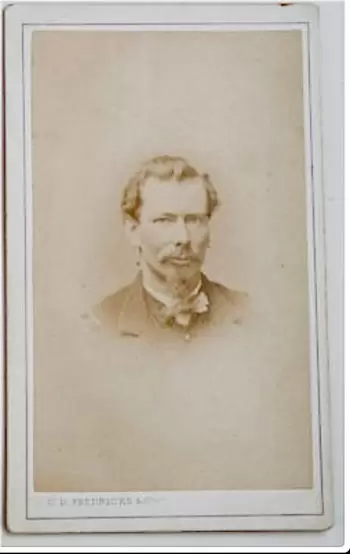
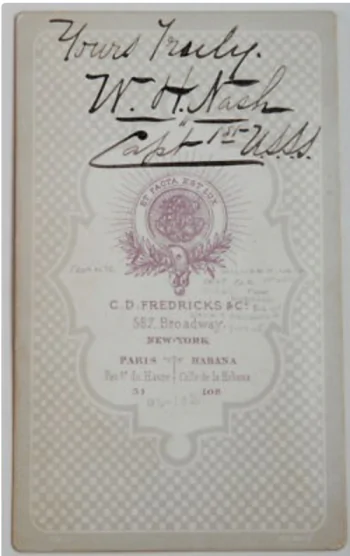
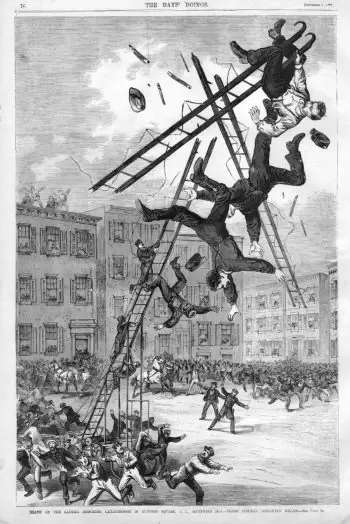
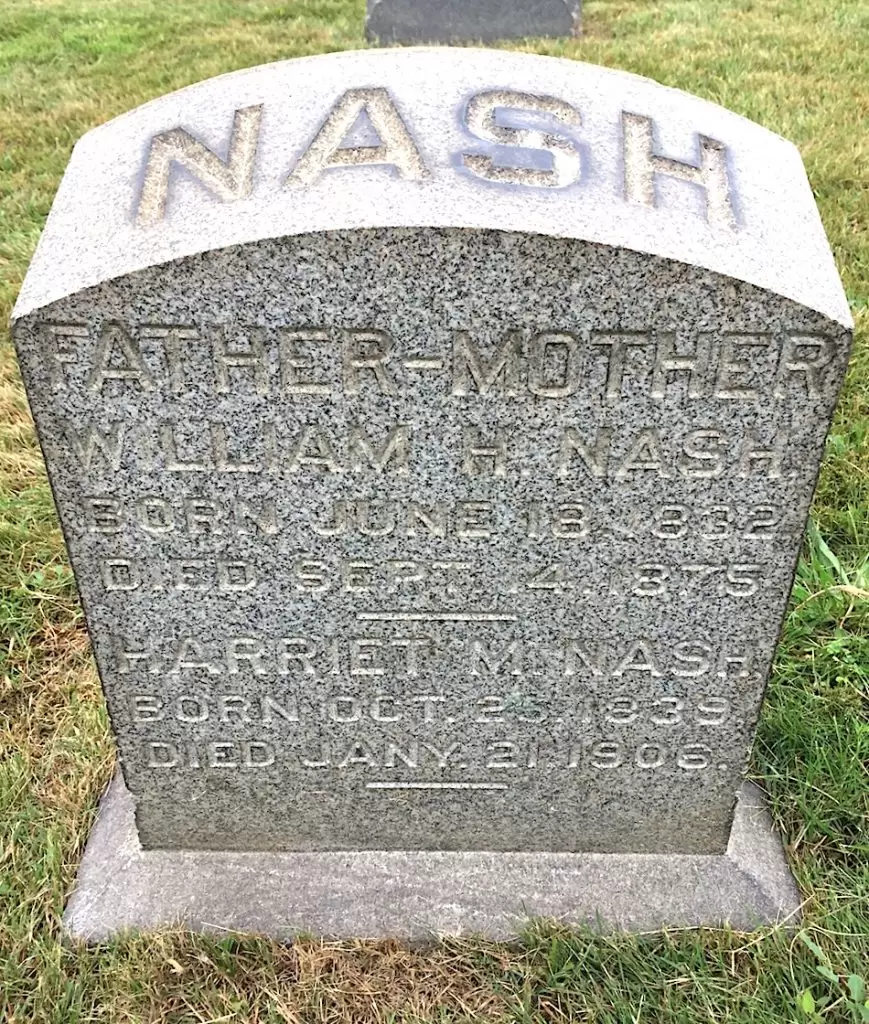
NATTRASS (or NATRASS), CHARLES L. (1844-1874). Musician, 23rd Regiment, New York State National Guard, Company A. Nattrass was born in Brooklyn. The federal censuses of 1850 and 1860 and the New York State census of 1855 report that he lived with his parents and siblings, including William (see), in Brooklyn; his father was a tinsmith. During the Civil War, he served as a musician in Company A of the 23rd Regiment, New York State National Guard, when it was activated for 30 days in 1863. The 1865 Brooklyn Directory and the 1870 census indicate that Nattrass was a store clerk; he was still living with his parents and siblings in Brooklyn. The 1872 Brooklyn Directory notes that he lived at 138 Fulton Street in Brooklyn and continued his employment as a clerk. As per his death certificate, he was single and worked as a clerk. According to Nattrass’s obituary in the Brooklyn Daily Eagle, relatives and friends of the family were invited to attend his funeral at his last residence at 138 Fulton Street in Brooklyn. Section 95, lot 5526.
NATTRASS (or NATRASS), WILLIAM (1842-1905). Musician, 43rd New York Infantry, Companies H, B and D. Nattrass was born in Brooklyn. The federal censuses of 1850 and 1860 and the New York State census of 1855 report that Nattrass lived with his parents and siblings, including Charles (see), in Brooklyn; his father was a tinsmith and William was an apprentice plumber at the time of the 1860 census. During the Civil War, he enlisted as a musician as Camp Griffin, New York, on March 1, 1862, and mustered immediately into Company H of the 43rd New York. Nattrass was transferred intra-regimentally to Company B on July 18, 1862, with the rank of drummer, and discharged as a musician at Park’s Station, Virginia, on March 7, 1865. One soldier record indicates that he was also in Company D during his service.
The 1870 census reports that Nattrass was living with his parents and siblings in Brooklyn and still working as a plumber. As per the 1872 Brooklyn Directory, he was a plumber whose home address was at 138 Fulton Street. The 1880 census reports that Nattrass was living with his mother and siblings in Brooklyn and was still working as a plumber. As per the 1883 Brooklyn Directory, he lived with his widowed mother and siblings at 426 Cumberland Street in Brooklyn; no occupation is listed. The 1900 census shows a William Nattrass, a tinsmith, living at Orange Farm, the County Poor House, in Goshen, New York. Section 95, lot 5526.
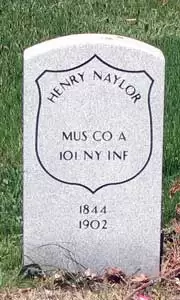
NAYLOR, HENRY (1845-1902). Musician, 101st New York Infantry, Company A. Naylor enlisted at his birthplace, New York City, on September 20, 1861, and mustered into the 101st as a musician on that day. As per his muster roll, he was a laborer who was 5′ 3″ tall with grey eyes, light hair and a fair complexion. His muster roll notes that he also served as a drummer. He was discharged for disability on January 16, 1863, at Convalescent Camp in Alexandria, Virginia.
The 1870 census reports that Naylor lived with his wife and infant son in New York City and worked as a gilder. His application for an invalid pension was granted in 1876, certificate 149,552. The 1879 and 1883 New York City Directories list him as a gilder. According to the census of 1880, which indicates that he worked as a gilder and operated a candy store, Naylor’s eyes were impaired during his service in the Civil War; at that time, he was married with five children. The 1900 census, which lists his birth date as July 1845, reports that he worked as a porter; his five children and four grandchildren are listed as living with him. His last residence was 209 East 52nd Street in Manhattan. His death was attributed to nephritis. Mary Naylor, who is interred with him, received a widow’s pension shortly after his death in 1902, certificate 548,356. Section 126, lot 5047.
NAYLOR, JR., JOHN (1843-1914). Private, 21st Connecticut Infantry, Company F; United States Army Signal Corps. Naylor was born in New York City and lived in New London, Connecticut, at the time of the 1860 census. During the Civil War, he enlisted as a private on August 11, 1862, and mustered into the 21st Connecticut on September 5. On November 30, 1863, he transferred into the United States Army Signal Corps from which he was discharged on June 24, 1865. As per his obituary in the Brooklyn Daily Eagle, which confirms his Civil War service, Naylor took part in the Battles of Fredericksburg, Virginia, and Fort Fisher, North Carolina.
After the War, Naylor was a merchant and belonged to the Ulysses S. Grant Post #327 of the G.A.R. The 1875 New York State census indicates that he lived on 3rd Street in Brooklyn; he was listed as an agent in the 1878 Brooklyn Directory and as a lead merchant in the 1880 census. In 1888, his application for an invalid pension was granted, certificate 824,358. Naylor’s obituary in the Brooklyn Daily Eagle notes that his uncle, Joseph Naylor, a wealthy man and member of the Old Guard of Manhattan, had left him much of his property when he died. John Naylor’s obituary in the Brooklyn Standard Union, which confirms his Civil War service in the Signal Corps and the relationship with his uncle, notes that he received an income from his uncle’s estate of which he was one of three executors. John Naylor was active in Republican Party politics but never sought elective office. The Brooklyn Standard Union reports that he was in the plumbing business and had attended All Saints’ Protestant Episcopal Church in Brooklyn. The 1904 Brooklyn Directory and the 1910 census note that he was in the real estate business; as per the 1910 census, he had remarried and was still living in Brooklyn. His last residence was 621 Eighth Avenue in Brooklyn. His death was attributed to heart disease. An article in the Brooklyn Daily Eagle on June 1, 1914, noted that Naylor’s name was read and commemorated by the Grant Post at the annual Memorial Day services and parade. Florence Naylor, who is interred with him, applied for and received a widow’s pension in 1916, certificate 820,615. Section 100, lot 959.
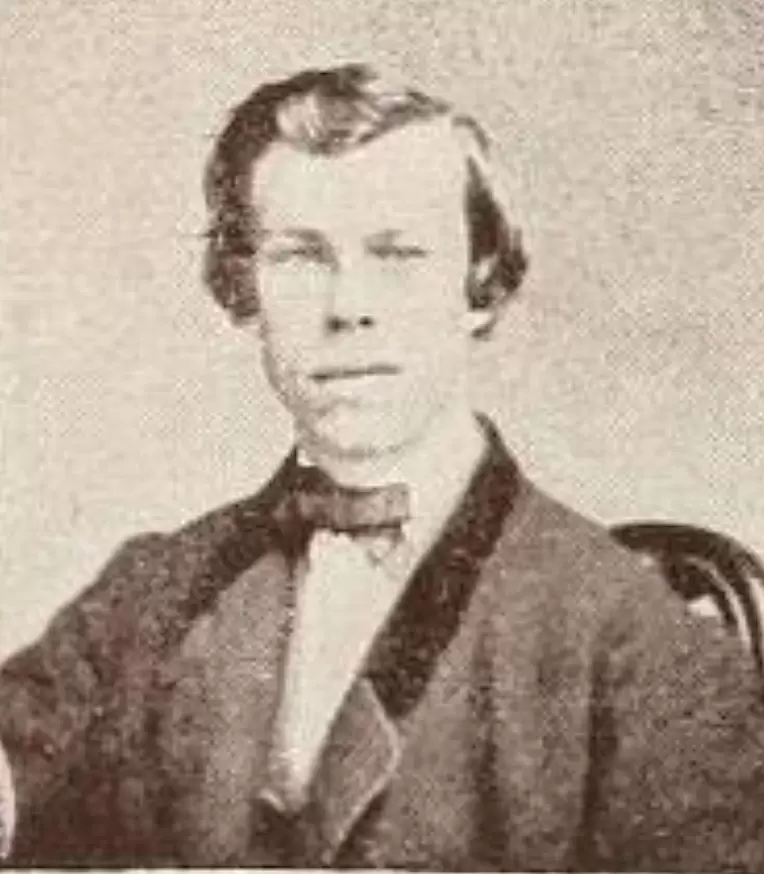
NAYLOR, ROBERT SPROULE (1839-1893). Private, 84th New York (14th Brooklyn) Infantry, Company E. A native of Newark, New Jersey, Naylor enlisted as a private at Brooklyn on April 18, 1861, and mustered into the 14th on May 23. Taken prisoner at Gainesville, Virginia, on August 28, 1862, he was later paroled. His muster roll lists him as present in October 1863. He mustered out on June 2, 1864, at New York City.
The 1874 and 1884 Brooklyn Directories and 1892 New York State census list Naylor as a letter carrier. In 1892, his application for an invalid pension was approved, certificate 850,601. As per his obituary in the Brooklyn Daily Eagle, he was a member of the Fourteenth Regiment Veteran Association, the Letter Carriers’ Association and the 1st Long Island Post #84 of the G.A.R.; members of those organizations were invited to attend his funeral. He last lived at 85 Myrtle Avenue in Brooklyn. Naylor died from heart disease. According to records of the Kings County Surrogate Court, dated March 8, 1893, he left his estate of about $3,000 in personal property to his four siblings, and a cousin; however, an itemized list of monies that he bequeathed totaled about $6,000 with two non-relatives receiving $100 each. Section 147, lot 22400.
NAZER, FERRIER (1825-1863). Lieutenant colonel, 4th New York Cavalry. Nazer was born in Suffolk, England. His baptism papers from Norfolk, England, record his name as Solomon Kelly Ferrier Nazer; his marriage certificate to Eliza Ellard recorded in London on September 28, 1847, notes his name as Solomon Kelley Ferrier Nazer. All of his United States documents use the name Ferrier Nazer. As per his obituaries in The New York Times and Frank Leslie’s Illustrated Newspaper, he was an adjutant in the British Army, serving with the 90th Light Infantry (reported incorrectly as the 19th Light Infantry in Frank Leslie’s Illustrated Newspaper), where he was esteemed as a gentleman and a soldier. On June 10, 1848, he arrived in New York City aboard the Wellington where his name on the ship’s manifest was Captain Ferrcer Nazer. As per the New York State census of 1855, he was living in New York and working as a clerk. Frank Leslie notes in his paper that Nazer took a position as the treasurer of the Winter Garden Theater where he made many friends in New York City.
However, Nazer’s military fervor returned during the American Civil War. After enlisting on November 1, 1861, at Hunter’s Point, Virginia, he mustered immediately into the Field and Staff of the 4th New York Cavalry as its lieutenant colonel. He commanded the 4th at the Battle of Cedar Mountain, Virginia, on August 9, 1862, and during operations in Northern Virginia from August 16 to September 2, 1862. Nazer led his company at the following Virginia skirmishes in 1862: Fairfax Court House on September 4; Ashby’s Gap on September 22; and at actions at Aldie and Berryville on November 29. On April 23, 1863, he died of typhoid fever at Washington, D.C. His obituary notes that he “was equally beloved by both officers and men, and his early military training, combined with undaunted courage and great self-possession, combined to render him one of the best and most efficient officers in the service.” The New York Times reported on May 7, 1863, that his funeral took place at St. Thomas’s Church before his burial at Green-Wood. On July 23, 1863, Eliza Nazer applied for and received a widow’s pension, certificate 20,894. Section 115, lot 13536 (Soldiers’ Lot), grave 10.
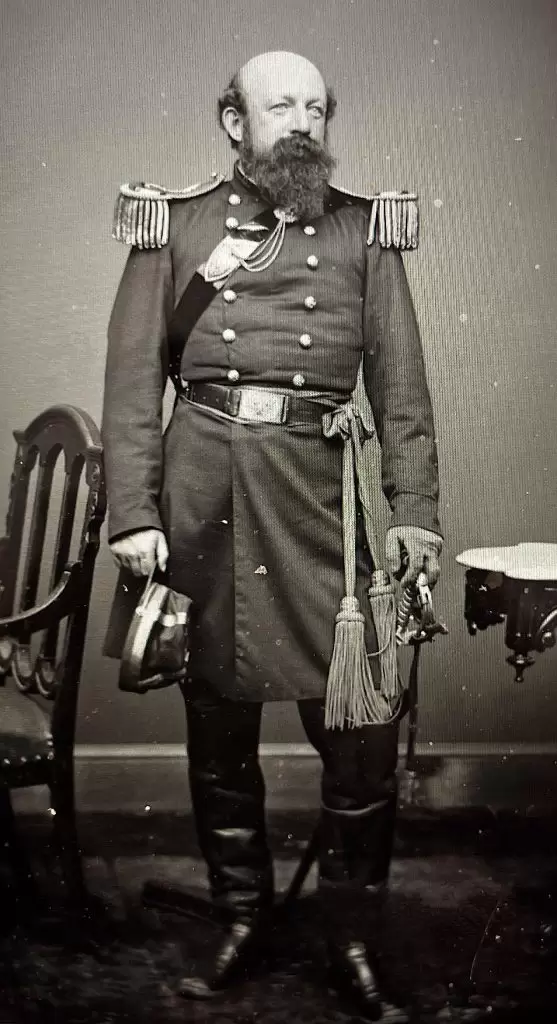
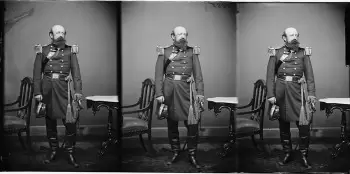
NEALL, JESSE H. (1834-1863). Private, 11th Regiment, New York Infantry, Company H. Originally from Philadelphia, Pennsylvania, he was a resident of Moreland Township, Philadelphia, at the time of the 1850 census. According to the 1859 Report of New York City’s Board of Aldermen, Neall was a member of Baxter Hook and Ladder Company No. 15 at 153 Franklin Street in Manhattan. He lived in the fire house and worked as a clerk. Neall enlisted as a private at New York City on April 20, 1861, and mustered into the 11th New York, also known as the Ellsworth Zouaves (for their colonel and organizer, Elmer Ellsworth) or the First Fire Zoaves (because many of its enlistees were volunteer firemen), on May 7. At the onset of the Civil War, the 11th New York formed a committee that asked fellow citizens for their support in providing under-clothing, overcoats, blankets and other contributions, citing their patriotism and willingness to offer their lives for the Union cause. The men from the fire houses escorted the regiment as it marched to receive its colors and join other Union soldiers on April 28, 1861. Throngs gathered along Broadway and Canal Street to cheer the men on and many of the men’s sweethearts presented their loved ones with gifts. A flag from the Fire Department, of fine silk trimmed with a yellow fringe, bore the inscription, “The Star-spangled Banner in triumph shall wave.” Presents and emblems were showered upon the soldiers as they departed on the USS Baltic on their way to Washington, D.C. Neall was among the signers of a Letter from the Zouave Camp (Camp Ellsworth) in Alexandria, Virginia, on July 3, 1861. The letter, in addition to apologizing for the need to repeat the narrative of goings on because of the irregular mail service, described the company’s leisure activities:
…In the absence of anything more exciting, our men are turning their attention, during the few spare hours they have from drill, to various amusement, amongst which may be reckoned “a right smart chance” of base ball players and quoit pitchers. Some come out in appropriate costume, too. “Yes indeed;” we saw Capt. [John] Wildey (see) yesterday under a very gay ball cap, and over an equally gay pair of ball shoes. Who’ da’ thunk it? Even the bold Colonel Cregier does not hesitate to pitch a quoit, and we think he knows how to do it. Of this we intend to be assured, as soon as the blacksmith sends home the quoits, as ordered. Just now, anticipation of the glorious Fourth, so near, and recollections of how many a one has been passed in one city of the Union, occupy all our minds, and lest you may suppose that we are to have no Fourth in Virginia, we send the following as a sample of the invitations that have been issued for a banquet to be given in honor of the day so so dear to us all.
CAMP ELLSWORTH, July 3, 1861
SIR:- You are respectfully invited to dine with the non-commissioned officers of Company H, in their tent, on the approaching Anniversary of our National Independence, at 1 P.M.
By honoring us with your company you will much oblige
Your obedient servants,
Corporal Jesse H. Neall, Sec’y (one of the five signatories)
He mustered out at New York City as a corporal on June 2, 1862. His muster roll indicates that he was borne on the State payroll but not paid. He died at St. Luke’s Hospital in New York City. As per his obituary in the New York Herald, he died of heart disease; newspapers in Philadelphia and Reading, Pennsylvania, were asked to make his obituary available to local readers. His obituary in The New York Times noted that his remains were taken from the house of Hook & Ladder Company No. 15 to St. John’s Church on Varick Street for his funeral. Section 114, lot 8999, grave 689.
NEBEL, OTTO (enlisted as OTTO, AUGUST) (1846-1895). Bugler, 1st New York Cavalry, Company E. Born in Germany, Nebel’s Lutheran baptismal record from Berlin reports his given name as Johann August Otto Nebel. He came to New York City on the ship Hansa which departed from Bremen, Germany, on July 4, 1863; his name on the ship’s manifest was Otto Nebel. During the Civil War, Nebel was borne on the rolls as August Otto. After enlisting as a private on January 25, 1864, he immediately mustered into Company E of the 1st New York Cavalry. As per his muster roll, he was a seaman who was 5′ 2″ tall with hazel eyes, dark hair and a light complexion. He was promoted to bugler before he mustered out on June 27, 1865, at Alexandria, Virginia.
The 1880 census reports that Nebel was employed as a customs inspector. According to an article in the Brooklyn Union-Argus on September 6, 1882, Otto Nebel was listed as a member of the First Ward Republican Association. As per an article in the Brooklyn Daily Eagle on January 6, 1883, about a gala sponsored by Rankin Post #10 of the G.A.R. that included installation of officers and entertainment, Nebel was listed as a member of the organization’s drum corps featured at the event. Subsequently, on May 19, 1883, the Brooklyn Daily Eagle listed Nebel as a bugler and quartermaster sergeant for the Memorial Day parade on May 30, 1883; that article noted that staff officers and G.A.R. members were requested to wear their military uniforms, Army hat, gilt cord and white gloves but no sash or side arms, to the event. The Brooklyn Directory for 1888-1890 lists him as a laborer. His name is recorded on the 1890 Veterans Schedule but it states incorrectly that he was in the 1st New York Artillery. In 1891, his application for an invalid pension, which notes both his alias and his given name of August Otto Nebel, was approved, certificate 849,905. His death certificate indicates that he was married and worked as a custom inspector. He last lived at 64 Court Street in Brooklyn. His death was caused by pneumonia. After his death in 1895, Caroline Nebel, who is interred with him, applied for and received a widow’s pension, certificate 428,128. Section 135, lot 27263, grave 934.
NEELY (or NEELEY), JOHN (1841-1907). First sergeant, 5th New York Infantry, Company C. Neely was born in New York City to parents of Scottish descent. The 1860 census reports that he lived with his mother and younger siblings in Manhattan and worked as a machinist. During the Civil War, he enlisted as a private at New York City on April 23, 1861, and mustered into the 5th New York on May 9. As per his muster roll which spells his surname as Neeley, he was paid $6.84 by New York State from April 25 through May 14. He was 5′ 10″ tall with blue eyes, dark hair and a ruddy complexion. Rising through the ranks, he was promoted to corporal on August 5, 1861, sergeant on October 29, 1861, and first sergeant on May 12, 1862. Neely was sick with rheumatism at New Bridge, Virginia, on June 27, 1862, hospitalized at Fort Monroe, Virginia, and returned to his regiment in September. On October 15, 1862, he was reduced in rank to sergeant and reduced in rank to private on December 15, 1862. Neely mustered out at New York City with his company on May 14, 1863.
After the Civil War, Neely was a locomotive engineer for the New York Central & Hudson River Railroad. According to the 1870 census, he lived with his mother and two younger siblings in Manhattan; he was employed as a machinist. He married Cynthia on October 11, 1871, at Elizabeth, New Jersey. The 1880 census shows that he was married, living at 456 West 31st Street in Manhattan and working as a railroad engineer. In 1880, he was operated on for a double inguinal hernia after which he wore a truss. The 1890 census reports that Neely lived at 459 West 35th Street in Manhattan and still worked for the railroad. His wife died in 1899. The 1900 census reports that he was a boarder living at 307 Amsterdam Avenue in Manhattan; a widower, he was employed as a stationary engineer. He was still listed as a boarder who lived in Manhattan on the 1905 New York State census. Neely was a member of the 5th Veterans Association and attended the Manassas Monument dedication in 1906. Although records of the Presbyterian Church state that he was buried at the North Presbyterian Church, that is incorrect; he was buried at Green-Wood on April 29, 1907, three days after his death. Section 81, lot 4531.
NEELY (or NEELEY, NEALLY, NEALY), ROBERT (1826-1866). Private, 139th New York Infantry, Company B; 2nd Battalion, Veteran Reserve Corps. Originally from Ireland, he is listed in the 1850 census as Robert Neally; at that time, he lived in New York City with his parents and worked as a laborer. During the Civil War, he enlisted at Brooklyn as a private as Robert Neeley on August 20, 1862, and mustered into the 139th New York on September 9. He was wounded in action at the Battle of Cold Harbor, Virginia, on June 2, 1864. On January 9, 1865, he transferred into the 2nd Battalion of the Veteran Reserve Corps from which he was discharged. Although he applied for an invalid pension on August 30, 1865, as Robert Neely, he died before it was certified. His obituary in the New York World lists his name as Robert Neely. He last lived in Brooklyn at 171 Taylor Street, the same address that is listed for Robert Nealy in the 1866 Brooklyn Directory. Section 64, lot 4713, grave 112.
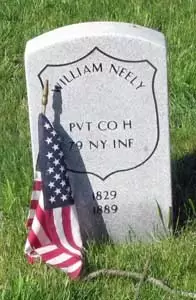
NEELY, WILLIAM (1829-1889). Private, 79th New York Infantry, Company H. Neely enlisted in New York City as a private on May 13, 1861, and mustered into the 79th New York on May 28. He deserted at Newport News, Virginia, on August 28, 1862. He last resided on Roebling Street in Brooklyn. Section 15, lot 17263, grave 2447.
NEIL (or NEILL), ARTHUR (1834-1887). Saddler, 5th New York Cavalry, Company A. Neil, who was born in Ireland, was 5’6″ tall, 130 pounds, with a dark complexion. He enlisted at New York City as a private on July 28, 1861, and mustered in on August 15. His muster roll uses the name, Arthur Neill. During his service, he was taken as a prisoner of war, paroled, and wounded in the right femur resulting in neuralgia and partial paralysis. The rifle ball apparently passed through the pelvis and lodged in the left groin. In September and October 1863, he was listed as being on the muster rolls but a surgeon’s certificate written in 1864 noted that he was wounded at Buckland Mills, Virginia, on October 29, 1863, hospitalized, and incapacitated. On April 28, 1864, he was transferred to a hospital in New York City. He was discharged for disability at New York City in August 1864. His soldier history stated that he was promoted to saddler during his service. Neil’s application for a pension was granted on September 5, 1864, certificate 78,183. The paperwork for increases in his pension noted that his left extremity was atrophied making walking and standing difficult. In subsequent years, it was indicated that the affected leg was weaker and had limited motion. The bullet remained in his groin, resulting in additional nerve damage from the injury as well as recurring epileptic fits. The 1870 census indicates that Neil lived in New York City and worked as a harness-maker; the 1888 Brooklyn Directory lists him as a harness-maker whose home address was 122 38th Street. According to his death certificate, he was a harness-maker. He last lived at 122 38th Street in Brooklyn. The application of Mary Neil, for a widow’s pension, was approved in 1887, certificate 243,517. Section 4, lot 21316, grave 293.
NEIL, RICHARD THOMPSON (1833-1900). Private, 2nd South Carolina Infantry, Company K; 4th Tennessee Cavalry, Company F, Confederate States of America. Born in Tennessee, he lived there in Bedford County and worked as a mercantile clerk, as per the 1850 census. During the Civil War, he enlisted as a private at Charleston, South Carolina, on May 12, 1861, and mustered into the 2nd South Carolina Infantry, also known as the 2nd Palmetto Regiment of the Brooks Guard Volunteers, on May 23 for one year. On January 27, 1862, suffering from pneumonia, he was admitted to Moore Hospital in Danville, Virginia, and sent to the General Hospital in Charlottesville. According to his muster roll of February 7, 1862, he was still hospitalized at Charlottesville, was owed a bounty of $50 as of December 31, 1861, and had his enlistment extended for two more years. On October 1, 1862, he re-enlisted at Franklin, Tennessee, and appeared on the muster rolls for the 4th Tennessee Cavalry, also known as McLemore’s Cavalry, in May and June of 1863. He deserted on July 10, 1863, and it is noted on the muster roll that he owed money for the use of a horse.
On December 18, 1866, Neil married Julia Ann Howard in Bedford, Tennessee. According to the 1870 census, the 1870 Brooklyn Directory and the 1875 New York State census, he lived in Brooklyn and worked as a store clerk; in 1870, he lived at 10 President Street. The 1878 Brooklyn Directory indicates that he lived at 542 Hicks Street; he was still working as a clerk and continued in that position at the time of the 1880 census. The 1900 census reports that he was living in Nassau County with his daughter and son-in-law and was employed as a clerk in a dry goods store. He last lived in Valley Stream, Long Island. Section 136, lot 28307, grave 136.
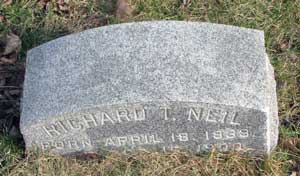
NEILL (or NEIL), JOHN (1845-1878). Private, 139th New York Infantry, Company A; Veteran Reserve Corps, 37th Company. Born in Ireland, Neill enlisted at Flatbush, Brooklyn, on August 23, 1862, and mustered into the 139th New York the next month on September 9. He was wounded in 1864 at Cold Harbor, Virginia, and lost the use of his right hand. On March 7, 1865, he was transferred to the Veteran Reserve Corps from which he mustered out on June 28, 1865, at Washington, D.C. On October 20, 1865, he applied for and received an invalid pension, certificate 76,149.
As per the 1875 New York State census, Neill was a letter carrier living on Prince Street in Brooklyn; he was married with one child. The 1876 Brooklyn Directory lists him as a letter carrier living at 366 Pearl Street. He was a letter carrier for the Brooklyn Post Office for ten years and had a route in the downtown neighborhood encompassing Joralemon, Court and Henry Streets, as well as Atlantic Avenue. As per his obituary in the Brooklyn Daily Eagle, the people along his route described him as steady, honest and hard-working. He was also active in the Rankin Post #10 of the G.A.R, and served as its officer of the guard. In addition, he was a member of the Independent Order of Odd Fellows, a fraternal organization.
An article in the Brooklyn Daily Eagle on June 28, 1878, notes that his funeral took place at the First Unitarian Church in Brooklyn Heights. Members of the Rankin Post assembled at his late residence and escorted their comrade’s body to the church. Post Office employees and many people along his mail route attended his services. Three members of his G.A.R. post and three letter carriers were pall bearers. The obituary reports that the casket was covered with the national flag and “on the lid there rested the side arms and accoutrements worn by the deceased when in the service.” Floral displays decorated the church and a choir sang anthems and hymns in a tribute to Neill. Although one source indicates that his last residence was in Newark, New Jersey, that is incorrect; his obituary notes that he last lived at 197 Prince Street in Brooklyn. His death was attributed to pneumonia and Bright’s disease. Lucy Neill applied for a widow’s pension in 1879, application 241,060, but there is no evidence that it was certified. An article in the Brooklyn Daily Eagle in June 1883 described how members of his G.A.R. post formed a convoy accompanied by a drum corps at the Long Island Railroad depot and proceeded to decorate the graves of veterans at Green-Wood with white roses, stopping first to honor Neill. Lot 1474, grave 86.
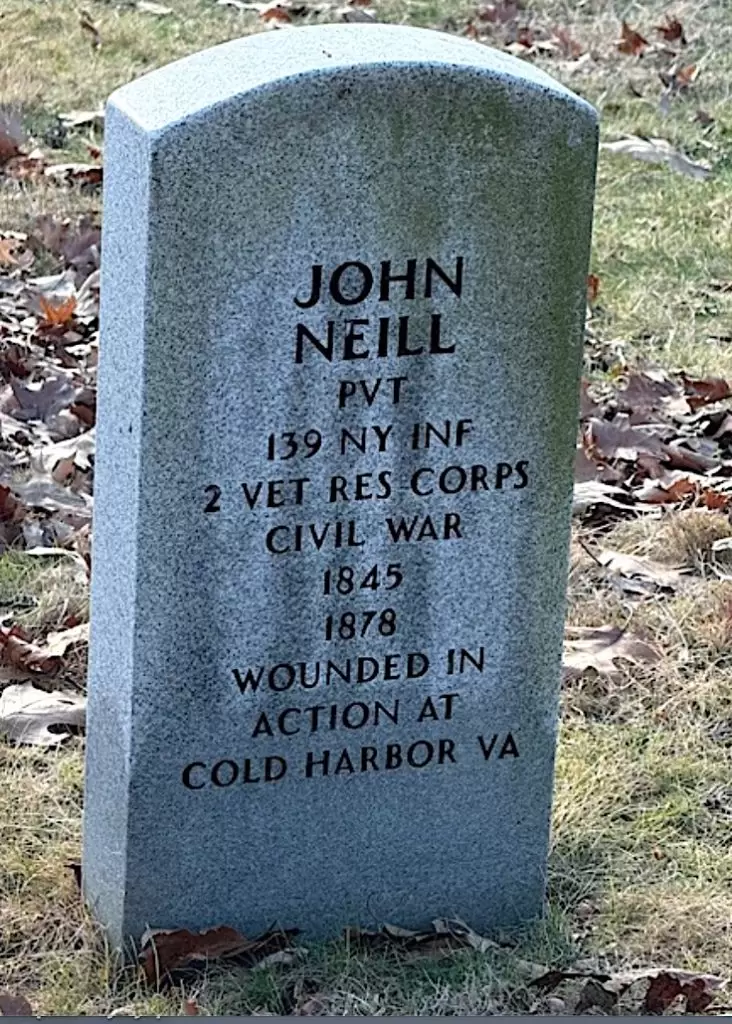
NEILL, ROBERT R. (1843-1887). Private, 2nd Pennsylvania Cavalry, Company K; 1st Provisional Pennsylvania Cavalry, Company K. A native of Dublin, Ireland, Neill enlisted as a private on February 28, 1865, and mustered immediately into the 2nd Pennsylvania Cavalry. He was transferred into the 1st Provisional Pennsylvania Cavalry on June 17, 1865, shortly before he mustered out on July 13, 1865, at Cloud’s Mills, Virginia.
On October 25, 1869, he married Mary Virginia Snedeker at the Grace Episcopal Church in Nyack, New York; the Neills had 10 children, the last two daughters, born in 1884 and 1886, died in infancy. The 1880 census reports that he lived in Philadelphia, Pennsylvania, with his wife and six children and worked as a laundryman; that census also indicates that his wife and three oldest children were born in New York. The 1883 Philadelphia Directory lists him in the laundry business. As per his death certificate, he was married and was a laundryman. He last lived at 611 South 10th Street in Philadelphia, Pennsylvania. The cause of his death was heart disease. The Neill’s fifth child, John Rea Neill, born in Philadelphia in 1877, was a magazine and children’s book illustrator, most famously known for his pen and ink drawings in all but the first of L. Frank Baum’s Oz series and all of the Ruth Plumly Thompson Oz books. In Baum’s 1904 work, The Marvelous Land of Oz, John R. Neill’s nieces, Marie and Roberta, were the models for Ozma and Dorothy. Section 150, lot 10209, grave 6.
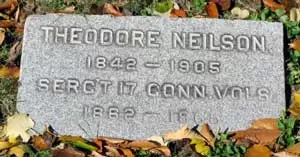
NEILSON, THEODORE (1842-1905). Sergeant, 17th Connecticut Infantry, Company K. Neilson was born in Van Cortlandtville in Westchester County, New York. He was living there at the time of the 1850 census; his father was a piano-maker whose real estate was valued at $10,000, a very substantial sum for that time. After Neilson enlisted as a sergeant at Fairfield, Connecticut, on August 13, 1862, he mustered into the 17th Connecticut on August 28, and mustered out on July 19, 1865, at Hilton Head, South Carolina.
On December 23, 1876, Neilson married Eliza Holmes Ladd in Manhattan. The 1880 census reports that he lived at 315 West 31st Street in Manhattan and was a railroad employee. The 1883 New York City Directory lists Neilson as an agent. Although his name is listed on the 1890 Veterans Census for Warwick, New York (Orange County), there is no information in that record detailing his service. In 1901, his application for an invalid pension was granted, certificate 1,046,797. His last residence was in Orange County, New York. His death was caused by phthisis. Section 76, lot 2478, grave 76.
NELLIS (or NEILLIS), JOHN L. (1845-1927). Private, 84th New York (14th Brooklyn) Infantry, Company E; 5th New York Light Artillery, Battery E; 5th New York Heavy Artillery, Battery D. Born in Albany, New York, Nellis lived in Brooklyn with his parents (his father was first in the sash and blind business and then a grocer) and siblings, as per the 1855 New York State census and the 1860 census. During the Civil War, John Nellis enlisted at Brooklyn as a private on November 2, 1861, the same date that he mustered into the 14th Brooklyn. As per his obituary in the Brooklyn Daily Eagle, he was one of three brothers who fought in the Civil War and that John Nellis joined his regiment before he was sixteen years old. He was discharged from service on August 10, 1862. After re-enlisting at Brooklyn as a private on August 16, 1862, he mustered into Battery E of the 5th New York Light Artillery, then joined the 5th Heavy Artillery a few weeks later on September 1. As per his muster roll, he was a clerk who was 5′ 8″ tall with blue eyes, light hair and a light complexion. On January 12, 1863, he was discharged from service by a writ of habeas corpus.
At the time of the 1865 New York State census, Nellis lived in Brooklyn with his parents and siblings and worked as a clerk. The 1874, 1878 and 1884 Brooklyn Directories list him in the dry goods business. The 1875 New York State census indicates that he was in the dry goods business and was married to his first wife, Julia. However, by the time of the Brooklyn Directories for 1884 and 1890 he was in the liquor business. The Veterans Census of 1890 confirms Nellis’s Civil War service. His 1906 application for an invalid pension was awarded, certificate 1,123,850. The 1905 census and the 1910 census report that he lived at 289 13th Street in Brooklyn with his second wife, Elizabeth; in 1905, he was a real estate broker and in 1910, he worked in a saloon. The Brooklyn Daily Eagle reported on February 3, 1914, that Nellis was one of the vice presidents of the United Liquor Dealers Association of Kings County; that organization held a private meeting to discuss ways to improve the retail trade. According to an article in the Brooklyn Daily Eagle on June 28, 1919, about the enforcement of the war-time prohibition act that was scheduled to go into effect on July 1, Nellis was listed as a trustee of the United Liquor Dealers Association of Kings County; he and others were planning to decide whether saloon operators would honor the enforcement of that act or test it by remaining open for business.
Remaining active in military affairs, he belonged to the Rankin Post #10 of the Grand Army of the Republic, was a member of the Joppa Lodge of the Freemasons, and of the 14th Regiment Veterans Association. The 1920 census and the 1925 New York State census report that he lived at 289 13th Street in Brooklyn; in 1920, he worked in a saloon. As per his obituary in the Brooklyn Daily Eagle, his funeral was held at the 14th Regiment Armory. His last residence was 289 13th Street in Brooklyn. His death was attributed to apoplexy. Elizabeth Nellis applied for and received a widow’s pension in 1926, certificate A-1-20-28. Section F, lot 18783.
NELSON, THOMAS M. (1833-1875). Mate, United States Navy. Born in Norway, Nelson began serving in the Navy as a mate on January 1, 1863. He continued his career at sea after the Civil War. As per his obituary in the New York Herald, which confirms his enlistment date, he was a mate in the Navy and had last served on USS Palos, a screw tug, in the Asiatic Squadron. In May 1871, the Palos was one of the five ships involved in the Korean Expedition, an operation to investigate the destruction of the General Sherman, an armed merchant marine steamer that visited Korea in 1866 to establish trade relations and receive assurances that American sailors shipwrecked in Korea would be treated fairly. While on that mission, one of the Selee River forts opened fire on the Palos as she crossed the Ganghwa Straits on June 1, 1871. The Palos and the gunboat Monocacy bombarded that fort and, on June 10, the expedition attacked in force capturing five of the six hostile forts; the forts were destroyed, over 200 Koreans killed and dozens of cannons were captured. The trade treaty, an original objective of the expedition, was not signed until 1882. Nelson’s death certificate notes that he was unmarried. The Brooklyn Daily Eagle indicates that Nelson’s funeral was held at the Central Baptist Church on Bridge Street in Brooklyn. He died at the residence of Henry A. Kloeppel, relationship unknown, at 70 Adelphi Street in Brooklyn. His death was attributed to phthisis. Section 147, lot 21697.
NESBITT, ANDREW (1834-1862). Third assistant engineer, United States Navy. A native of New York State, Nesbitt served aboard the gunboat USS Whitehall as third assistant engineer as of February 13, 1862. He was killed instantly by a shell fragment in battle with the Confederate iron-clad Merrimac off Newport News, Virginia, on March 9, 1862. Section 126, lot 5047, grave 353.
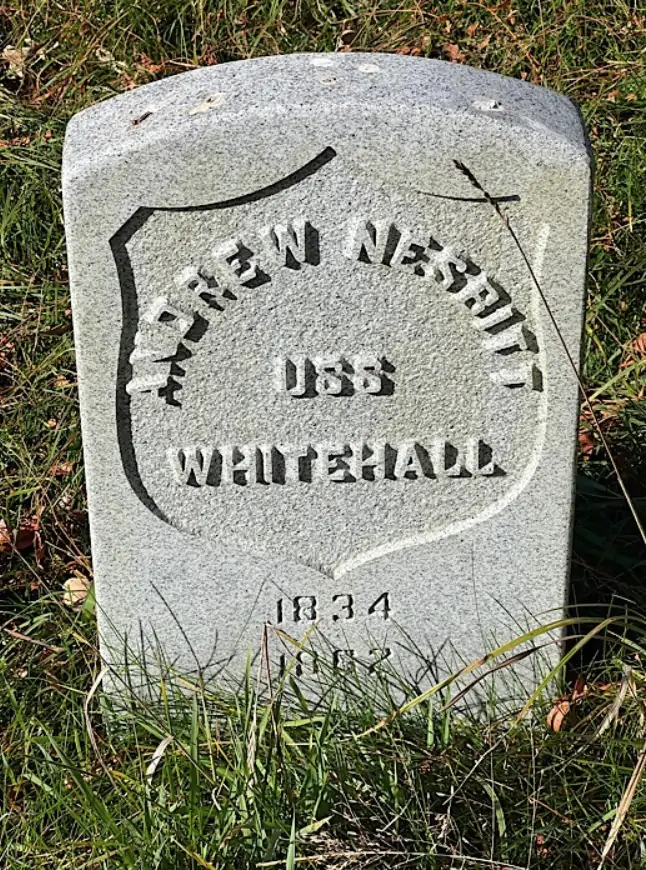
NESMITH, HENRY EDWIN (1828-1901). Private, 6th New York Heavy Artillery. A Brooklyn native, he enlisted as a private on August 22, 1864, at Tarrytown, New York. He mustered into the 6th New York Heavy Artillery the same day and mustered out at Hart’s Island, New York Harbor, on May 6, 1865.
He served as a director of the Mechanics’ National Bank for forty-eight years, and owned Nesmith and Sons, Shipping and Commission Merchants, located for 50 years at 28 South Street in Manhattan. According to his obituary in the Brooklyn Daily Eagle, he was a member of the Hamilton Club. A ship, the Henry Nesmith, was named in his honor. His last residence was 117 Remsen Street, Brooklyn, a house that he built and lived in for forty-eight years. Section 120, lot 402, grave 11.
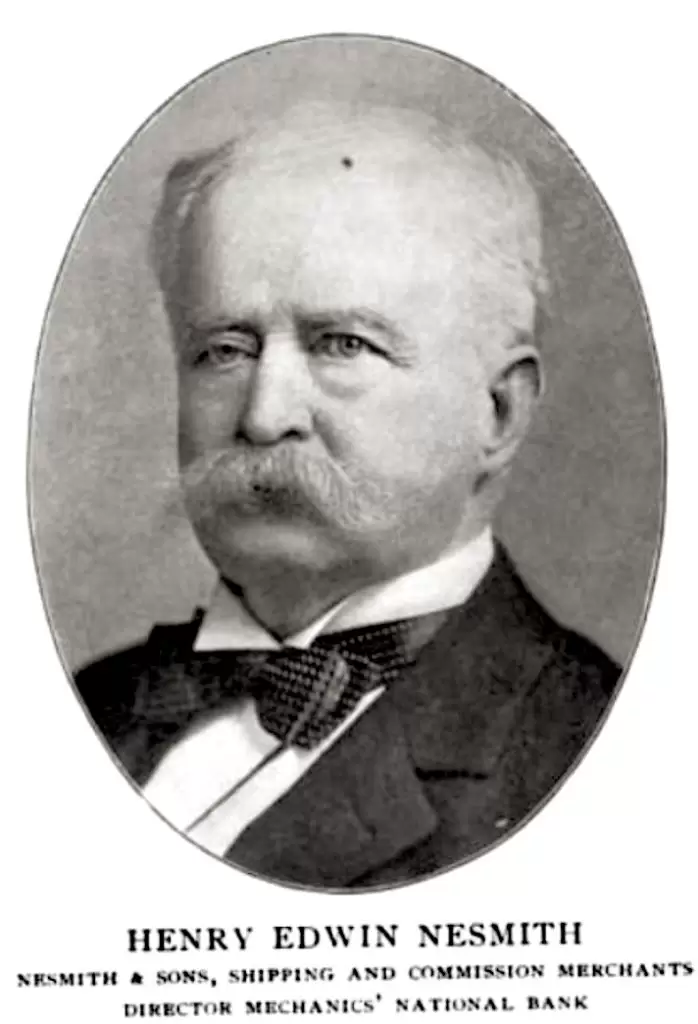
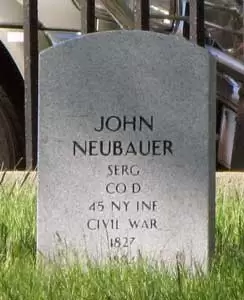
NEUBAUER, JOHN (1827-1894). Sergeant 45th New York Infantry, Company D. Of German origin, Neubauer enlisted as a sergeant on September 2, 1861, at New York City, and mustered into the 45th New York seven days later. The 45th New York, known familiarly as the 5th German Rifles, consisted almost entirely of German immigrants. He was listed as a prisoner of war on July 1, 1863, at the Battle of Gettysburg, Pennsylvania, and was returned on July 25, 1864, place not stated. He mustered out on October 8, 1864, at Nashville, Tennessee, at the expiration of his term.
As per the 1887 Brooklyn Directory and the 1880 census, Neubauer was a shoemaker at 110 Degraw Street and lived in Long Island City; he was married at the time of the 1880 census. Neubauer was admitted to the National Home for Disabled Volunteer Soldiers in Dayton, Ohio, in 1889 for “general disability.” His paperwork there notes that he was a widower, had been a shoemaker in Hoboken, New Jersey, and was 5′ 5″ tall with hazel eyes, dark hair and a dark complexion. In 1890, his application for an invalid pension was approved, certificate 625,586. His death certificate notes that he was a widower and was a shoemaker. He died at St. Mary’s Hospital in Hoboken, New Jersey, while on furlough from the National Home. His death was attributed to apoplexy. Section 14, lot 19438, grave 34.
NEUBERT, FREDERICK (1831-1883). Private, 159th New York Infantry, Company D. Originally from Germany, Neubert enlisted at Brooklyn as a private on September 10, 1862, mustered into the 159th New York on November 1, and was discharged on an unknown date. According to the muster rolls, he was a baker by trade, 5′ 6″ tall with gray eyes, brown hair and a light complexion. He last lived on 15th Street near Fourth Avenue in Brooklyn. The cause of his death was cancer of the liver. Section 202, lot 27427.
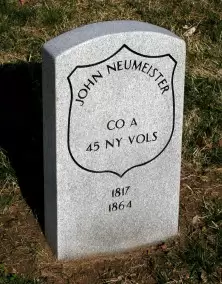
NEUMEISTER, JOHN (1817-1864). Private, 45th New York Infantry, Company A. Although Green-Wood records report that he was born in Germany, Neumeister’s muster roll indicates that he was born in Austria. During the Civil War, he enlisted on October 4, 1861, and mustered into Company A of the 45th New York that same day. His muster roll shows that he was an upholsterer who was 5′ 8″ tall with gray eyes, brown hair and a light complexion. Neumeister re-enlisted on January 4, 1864, and died of phthisis four months later at City Hospital in New York. Section 115, lot 13536 (Soldiers’ Lot), grave 86.
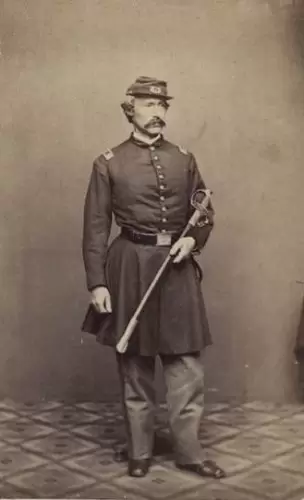
NEVERS, JR., BENJAMIN M. (1823-1877). Major, 7th Regiment, New York State Militia, Company F. A native of Boston, Massachusetts, Nevers enlisted as a captain on April 17, 1861, at New York City, was commissioned into Company F of the 7th Regiment nine days later, and mustered out at the expiration of the 30-day activation on June 3 at New York City. He returned to the 7th Regiment for three months in 1862, when it was part of the New York State National Guard, and was promoted to major on May 25 and commissioned into the Field and Staff on that date. The New York Times, on May 27, 1862, reported on the gathering of soldiers at the 7th Regiment’s Armory where they were greeted by Colonel Marshall Lefferts (see). The men, who eagerly answered the call to the defense of Washington, D.C., were stirred by Lefferts’s oratory and after gathering their military paraphernalia, were ready for a triumphant march down Broadway where they were cheered by flag-waving crowds and saluted with fireworks. That article lists Nevers as the major of the 7th Regiment. He mustered out on September 5 at New York City.
According to the 1867 New York City Directory, Nevers was a banker. Virginia Nevers, Benjamin’s wife who is interred with him, died at age 36 in 1870. The 1870 census and the 1877 New York City Directory indicate that he lived in New York City and worked as a broker; the 1877 Directory reports that he lived at 11 West 30th Street. As per his death certificate, Nevers was a widower and worked as a broker. Obituaries in the New York Daily Tribune and the New York Evening Express indicate that his funeral at the Trinity Chapel on 25th Street and Broadway, was largely attended by members of Company F of the 7th Regiment and veterans of that regiment. His last residence was at 145 West 35th Street. His death was attributed to cancer. Section 53, lot 5581.
NEVILL (or NEVILLE), MOSES M. (or N.) (1831-1866). Sergeant, 93rd United States Colored Infantry, Company G; private, 81st United States Colored Infantry, Company H. Nevill was born in New York State. Listed on the rolls as Moses Neville, he served as a private in the 81st United States Colored Infantry (USCT) and as a sergeant in Company H of the 93rd USCT. His name is displayed on the African American Civil War Memorial in Washington, D.C., plaque C-95. He last resided in Maspeth, Queens. Section 86, lot 5229, grave 40.
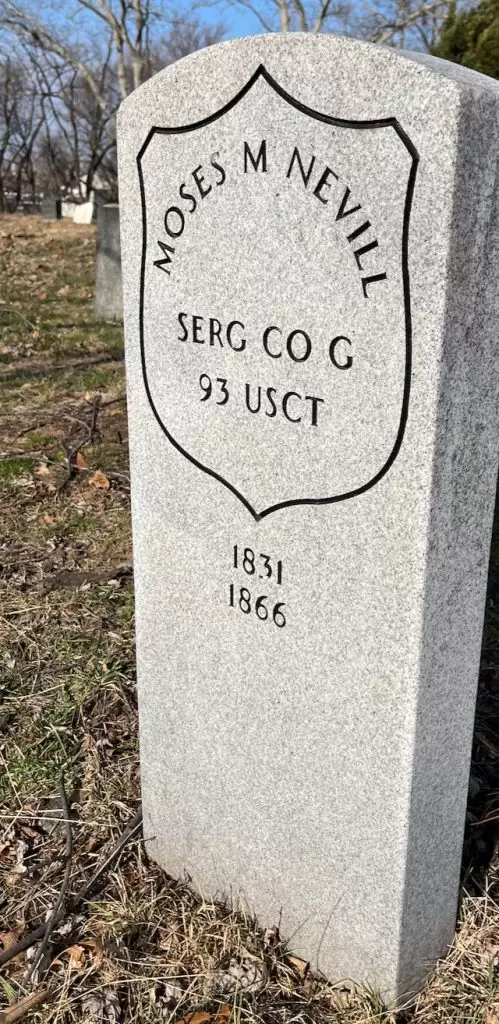
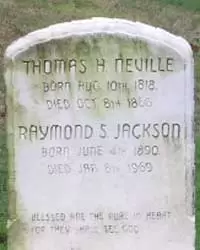
NEVILLE, THOMAS H. (1818-1866). Private, 176th New York Infantry, Company C. Private, 176th New York Infantry, Company C. Neville was born in England. As per the 1855 New York State census, he was a bookkeeper living in Albany with his wife, daughters and extended family. During the Civil War, Neville enlisted as a private at New York City on September 29, 1862, mustered into the 176th on December 18, and was discharged by civil authority on January 8, 1863, at New York City. The 1863 Draft Registration lists him as a clerk. He last resided on Macdougal Street in Manhattan where he died from cholera. Section 81, lot 13171.
NEVINS, WILLIAM RUSSELL (1826-1881). Engineer and recruiter. An engineer who invented machinery and a baking oven, Nevins raised a regiment of bakers and engineers in 1861, brought them to Washington, D.C., but ultimately disbanded the unit when it did not muster. He subsequently petitioned Secretary of War Stanton and received the approval of President Lincoln to supply troops with flour and his patented ovens. His letter of June 12, 1863, in the original language, received by the Volunteer Service Branch, Adjutant General’s Office, appears below:
I beg leave to submit my petition to your consideration, and your report, in the month of April 1861. I addressed a letter to the late then Secretary Cameron, War Department, as follows- In view of the present emergency, and his Excellency, the President’s Proclamation for volunteers to aid in protecting our glorious union, I do hereby most cheerfully volunteer my humble services to maintain the stars and stripes of our glorious union. I also offered the use of six of my patented biscuit machines to manufacture bread for the Army at Washington-with a regiment of 1200 men, all practical engineers & mechanics. Mr. Cameron promised to give me my col. commission, his Excellency the President, also promised to back me. The Honorable William H. Seward very respectfully recommended my petition to the President’s favorable consideration but I fear that it has been mislaid or from the press of business neglected and I therefore beg leave to address to your honor its favorable consideration.
I have erected three mechanical baking establishments to manufacture bread for the Army at a great outlay of money, these bakeries has reduced the price of bread at least 50 per cent to the government. The expenses of these baking establishments has been private enterprise, for which I am a very great loser of money & time, I having one of these baking establishments on hand 6 months without any contract, or parties to take hold of it.
I beg you to lay my case before the President, or to the proper department. I pray that my col. commission may be granted to me-although my Regiment of Bakers and Engineers did not come directly into government service, I brought them indirectly to government employment.
With sentiments of the highest personal regards, I have the honor to be very respectfully your most obedient lieut.
Wm. R. Nevins
Engineer, 89 Third Avenue
New York
N.B. I can enroll at your command, 4 Regiments of Practical Engineers & Mechanics, which would be of service in the West.
Nevins was in Washington, D.C., on April 12, 1865, just prior to the assassination of President Abraham Lincoln. An article in Harper’s Weekly on June 10, 1865, “Trial of the Conspirators,” notes that Nevins testified at trial that he visited Kirkland House where he met one of John Wilkes Booth’s co-conspirators, George Andrew Atzerodt, the man assigned to kill Vice President Andrew Johnson. Nevins was there asked by Atzerodt where Vice President Andrew Johnson was staying, pointed to the room and said that Johnson was at dinner. Atzerodt looked in the dining room at which point Nevins lost sight of him. Atzerodt, who never carried out the assassination of Johnson assigned to him, was convicted and soon hanged with the three other co-conspirators in Washington, D.C., on July 7, 1865.
On October 25, 1865, a note in The New York Times placed on record a tribute to the “ingenuity and energy” of Colonel William R. Nevins for contributing 250 to 3,000 barrels of flour that were “daily turned into most excellent bread for our soldiers in the field. His patent mechanical bakery was introduced by order of President Lincoln and was the direct and indirect means of preserving thousands of lives.” Nevins last resided in Rochester, New York. Section 33, lot 6182.
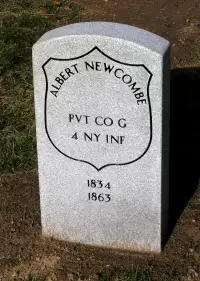
NEWCOMBE (or NEWCOMB), ALBERT (1834-1863). Private, 4th New York Infantry, Company C. Of English birth, he enlisted at New York City as a private on April 23, 1861, and mustered into the 4th New York Volunteers, also known as the Scott’s Life Guards, on May 2 of that year. He mustered out on May 25, 1863, at New York City. Newcombe last lived in New York City where he died of phthisis (tuberculosis) at St. Luke’s Hospital. A marble Veterans Administration stone was ordered for him early in the 20th century. Section 115, lot 13536 (Soldiers’ Lot), grave 79.
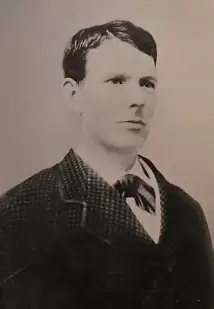
NEWCOME (or NEWCOMB), LOUIS ALLEN (1844?-1930). Private, 60th Massachusetts Infantry, Company B; drummer boy, 4th Massachusetts Infantry. Born in Braintree, Massachusetts, Newcome’s birth year is unclear. Although all of his New York City newspaper obituaries indicate that he born in 1844, another source states that he was born in 1852 and the New Rochelle Pioneer reports that he was born in 1848. However, on his 1912 passport application, Newcome states his birth date as July 21, 1846. Newcome’s grandfather participated in the Revolutionary War, was captured and sent to England but escaped from an English prison and made his way back to America.
As per a biographical sketch, at age fourteen, Louis ran away from boarding school to join the Union Army as a drummer boy for the 4th Massachusetts Infantry; his obituary in the Brooklyn Daily Eagle notes that he was a drummer boy for the 60th Massachusetts. As per soldier records and his pension index card, he enlisted on July 11, 1864, and mustered into Company B of the 60th Massachusetts five days later. As a drummer boy, he was entrusted with delivering a message to President Abraham Lincoln. Lincoln was very impressed with Newcome and arranged for him to transfer to special duty at the White House. He then worked as a spy behind enemy lines for the Union. In one biographical sketch, Newcome recollected that he once “appropriated” a horse and found himself in a peach orchard near Baltimore. While collecting “forbidden fruit,” he overheard Confederates talking about destroying the Baltimore & Ohio Railroad tracks. Newcome quickly mounted his horse and raced back to inform Union troops about the plot; his action saved the railroad tracks but the stolen horse died at the end of the journey.
Newcome also recalled that he preferred action to drumming. At the Battle of Honey Hill, South Carolina, he was in the midst of the action when he grabbed the colors and didn’t realize that he had been stabbed by a bayonet until a comrade noticed his blood-stained clothing. After a week in the hospital, he rejoined his regiment and went off with Major General William Tecumseh Sherman’s Army. As per soldier records, the 60th mustered out on November 30, 1864, at Indianapolis, Indiana, where it was ordered to avert danger from certain disloyal elements. It is unclear whether Newcome was still with the 60th Massachusetts at muster out because action at Honey Hill took place on that date and was the third battle in Sherman’s March to the Sea.
According to Kate Field’s Washington (Volume 10, July 4, 1894), he came North in 1869, after working with the Freedman’s Bureau and became associated with the United States Secret Service. The 1876 New York City Directory lists Newcome as a deputy marshal. Newcome made his first venture as head of a detective agency in 1876 at 83 Cedar Street in New York City but left to take a position in Washington, D.C., in 1881 with the United States Postal Service. In the aforementioned position, he was a postal inspector in New York City. As per United States Mail (January 1887, page 36), Newcome was “one of the keenest and shrewdest men ever in the employ of the Post Office Department.” His reputation was untainted, his manner gentlemanly, and he never made an arrest unless he was sure that the accused was guilty. That article cited his pursuit of the Paddy Ryan Gang of Post Office burglars, a group from the East Side of New York City who robbed forty-nine post offices in Connecticut during 1880-1881. Once Newcome assumed charge of the case, he soon arrested the men who later served time at the state prison in Wethersfield, Connecticut. He was also praised for convicting eight men of the Shawangunk Post Office Mountain burglars. Newcome achieved great success in the Post Office. Out of 347 cases brought before the United States Court during his tenure, convictions were obtained in all but two cases.
As head of a detective agency that bore his name as of 1887, Newcome was described as boyish in looks, inspiring confidence, honest and kind. He told Kate Field that people who have gone astray could be cured with “charity, cleanliness, pure water, well cooked food, airy apartments, manual training, school reading rooms, coffee houses, concert halls, theaters, libraries, and contact with men and women born under happier stars, whose hearts are as big as their bank accounts!” The 1888 New York City Directory lists Newcome as a detective at 651 Manhattan Avenue. An article about Newcome in the New Rochelle Pioneer on March 28, 1903, noted that he had a pleasant country home there and spent his leisure time on his yacht, the Grace. That article also notes that he was a member of the New Rochelle and Manhasset Bay Yacht Clubs, the Freemasons, and the West Side Republican Club. In 1909, his application for a pension was approved, certificate 1,156,749. The 1910 census reports that he lived in Manhattan and had an investigating office. According to his passport application of March 5, 1912, he lived at 2 Rector Street in Manhattan and described himself as 5′ 8″ tall with dark blue eyes, light gray hair, full face, light complexion and medium forehead, nose, and chin. A hand-written note on the aforementioned application indicated “Please Rush”-applicant leaving New York on the SSAmerika at 10:00 a.m. on March 7. His detective agency was still listed in the New York City Directory for 1925.
Newcome wrote about his experiences as a post office detective and in 1929, he recalled his experiences during the Civil War in the book, Lincoln’s Boy Spy. As per the 1930 census, he was living in Manhattan but no occupation was noted. His death certificate, which indicates a birth year circa 1844, notes that Newcome was a retired bank investigator. As per his obituaries in The New York Times and the New York Sun, which confirm his Civil War service and role as a personal messenger of President Lincoln and boy spy, he was a widower and member of New York City’s Old Guard; both obituaries refer to him as Captain Newcome. His role as a drummer boy and messenger to President Lincoln were also confirmed in his obituaries in the Brooklyn Daily Eagle and the Brooklyn Standard Union. He last lived at 90 Riverside Drive in Manhattan. Section 200, lot 26657, grave 4.
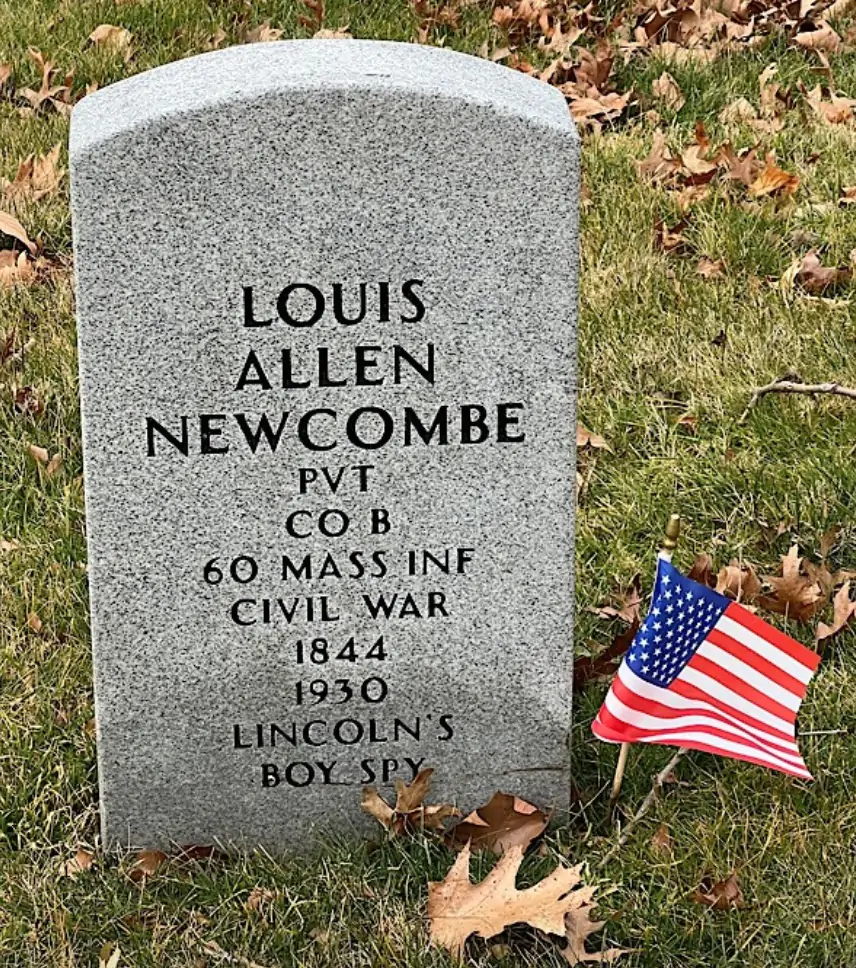
NEWKIRK, BENJAMIN (1816-1863). Lieutenant, 8th Regiment, New York State Militia, Company G. As per his obituary in the New York Herald, Newkirk, an ex-lieutenant in the 8th Regiment, died at his home in Fordham in Westchester, New York, from gastric bronchitis. Members of his Masonic lodge and members of the 8th Regiment were invited to attend his funeral. Philadelphia and New Haven newspapers were asked to copy his obituary. He was also listed as a lieutenant in the 131st Infantry as an officer whose service terminated prior to January 1, 1858. Section 50, lot 8765.
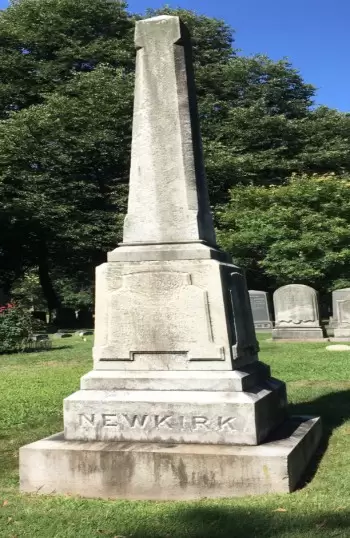
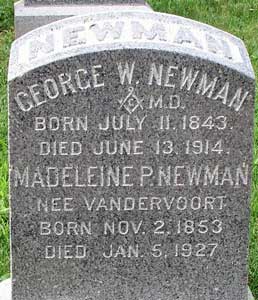
NEWMAN, GEORGE W. (1843-1914). Assistant surgeon, 5th New York Heavy Artillery. A native New Yorker, he graduated from New York University, then enlisted at Williamsburg, New York, on March 2, 1865, and mustered into the Field and Staff of the 5th New York’s Heavy Artillery on March 14. He mustered out on July 19 of that year at Harpers Ferry, West Virginia.
Setting up a medical practice in the Eastern District of Brooklyn (Williamsburg), Dr. Newman practiced there for 50 years, and also worked as a medical inspector for the Brooklyn Board of Health. A member of the Kings County Medical Society, his father and three of his four sons were also physicians. He belonged to the Thomas S. Dakin Post #206 of the G.A.R. His last residence was 234 Leonard Street in Brooklyn, but he spent much time in Huntington, Long Island, where according to his obituary in a local newspaper, “… he was quite well known.” His death was caused by sclerosis. Section 30, lot 9438.
NEWTON, JR., ISAAC (1837-1884). Engineer, United States Navy; private, 7th Regiment, New York State Militia, Company B. Born in New York City, his father, Isaac Newtown, owned the North River Steamer that bore his name and other steamers. Newton Jr. earned a degree in civil engineering from the University of the City of New York in 1856 and a State of New York Engineer’s Certificate in 1859. From 1856 through 1857, he was an assistant engineer on an ocean liner that made transatlantic New York to Liverpool runs. As part of his engineering work, he made a survey of the shoals of the upper Hudson River with a view toward improving navigation there.
At the onset of the Civil War, Newton enlisted in the 7th Regiment for its 1861 activation, which lasted from April 18, 1861 to June 3, `861. Newton then re-enlisted on June 15 as a first assistant engineer in the United States Navy, was assigned to the USS Roanoke until December 1, 1861, during which time he did blockade duty in Charleston Harbor, South Carolina. He was then assigned to special duty at New York on November 29, 1861. Detached to “Ericsson’s Battery,” he assisted John Ericsson in the construction of the USS Monitor in Greenpoint, Brooklyn. As per a biographical sketch, Newton worked under Allan C. Stimers, the supervising engineer, and became chief engineer of that vessel on February 7, 1862. He held that position on that ship’s maiden voyage and participated in the historic naval duel with the CSS Merrimack on March 8-9, 1862, and the attack upon Fort Darling, Virginia, on August 14, 1862. Newton left the Monitor on August 20, 1862, and was detached to take the position of Superintendent of Construction of ironclads in New York City. He was commended by Captain John L. Worden on the Monitor, “In the emergency which arose on the passage to Hampton Roads he showed great readiness in resources, and quickness in the application of them. In the action with the Merrimac (sic) he did his duty with coolness, skill and energy.” However, despite Newton’s laudable work, as the New York Tribune reported, his name did not appear on the testimonial to the Monitor presented by the New York State Assembly in March 1862 to Ericcson, Worden and Stimers. Newton was assigned to special duty at Port Royal on January 1, 1863, and then transferred to New York on March 16, 1863, to superintend the building of ironclad vessels. He was detached to work with John Ericcson on the USS Madawaska on January 23, 1865. Newton resigned on February 8, 1865, after accompanying many ironclads to their destinations and defending the pioneering technology in numerous journals.
After the Civil War, Newton worked on a drainage project in Lake Margaree in Nova Scotia, Canada. Subsequently, he was a consultant for a coal and iron company and then was appointed as an assistant to former Major General George B. McClellan, the chief engineer of the Department of Docks. Newton’s 1875 passport application describes him as 5′ 10½” tall with hazel eyes, aquiline nose, high forehead, light brown hair, oval face and fair complexion. In 1875, New York City Mayor William Wickham appointed Newtown engineer of the Rapid Transit Commission to work on routes for the elevated railways. The 1880 census noted that he was single and lived in New York City with his mother and sisters. Prominent in his field of engineering, he was a commissioner of the United States Court of Claims and one of the trustees of the Brooklyn Bridge. Newton was appointed chief engineer of the Croton Aqueduct on March 15, 1881, and was a member of the Society of Civil Engineers and the Society of Mechanical Engineers. A member of the Century Club, there was some controversy over Newton’s position as chairman of its House Committee, a position that he held for three years until January 1, 1883. After he stepped down from that position, the steward of the club charged that Newton had destroyed vouchers and had defrauded the club of $1,000. Newton appeared before an investigatory board with counsel; the board found that the charges were not substantiated by the evidence. Frail in appearance, Newton was described as nearly six feet tall but thin and emaciated in appearance. He had light blond hair and a long mustache, dressed neatly and avoided attention.
On September 25, 1884, Newton committed suicide. As per extensive articles on his death in the New York Tribune and the New York Herald, which confirmed his service on the USS Monitor, he had slit his throat after being “made insane by illness and worry.” The articles noted that Newton took his life in one of his rooms at his bachelor apartment at 20 Union Square overlooking Fifth Avenue and 14th Streets in Manhattan. As per the New York Herald, Newton lived in one of the apartments of the Century Club, of which he was a member. The New York Tribune reported that Newton’s apartment was plainly furnished but on one wall was a framed medallion of Newton and a drawing that represented a cross-section of the Monitor. Dr. Daniel Stimson, his personal physician, testified at the coroner’s inquest that Newton had suffered from numerous maladies over the last years of his life including typhoid fever, malaria, pneumonia and insomnia. In addition, Newton was in financial trouble, had loaned money to a friend and feared imprisonment. Dr. Stimson stated that he thought that Newton was insane at the time of his suicide. Newton’s friend of twenty years, William Lawrence, who lived in the same building, was with him the night of the suicide. Lawrence testified that Newton never exhibited signs of insanity before that night but was particularly troubled and thought neighbors were persecuting him that day. Although Lawrence stayed with him and discouraged him from handling a revolver that Lawrence owned, his efforts ultimately failed when Newton left for a moment to go back to his own apartment. Newton went into a closet and returned bloodied and near death with blood pouring from his throat and on his clothing. Lawrence tried to get help but it was too late. Newton’s lawyer also testified that Newton was worried about financial failure of a company that his father’s estate had invested in. The coroner’s jury concurred that Newton was insane at the time of his death.
Another news article after his death indicated that Newton’s death would not seriously embarrass or delay work of the Aqueduct Commission. In that article, Hubert O. Thompson, Commissioner of Public Works, stated that he was affected by the loss of his colleague and noted that Newton had made a major contribution in preparing the plans for the new Aqueduct and Quaker Bridge Dam. The Aqueduct Commission then adjourned their meeting and offered condolences on the sudden death of their associate. Unlike the obituaries in the New York Herald and the New York Tribune, Newton’s obituary in The New York Times made no mention of his service on the Monitor.
Newton’s funeral took place at the home of his mother at 26 West 21st Street in Manhattan. As per an article about his funeral in the New York Herald on September 28, 1884, Newton’s body lay in a cloth-draped casket; his service was attended by many of his colleagues and associates of his engineering projects including Commissioner Thompson. The newspaper reported that the Department of Public Works remained open during his funeral because the Newton family did not want any “display.” Section 77, lot 1912.
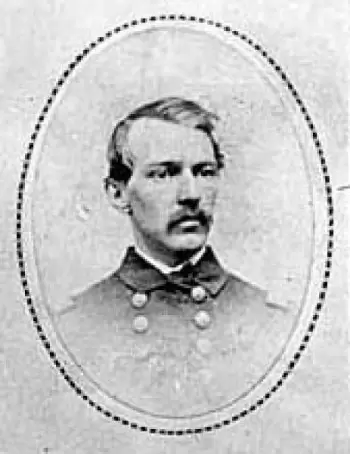
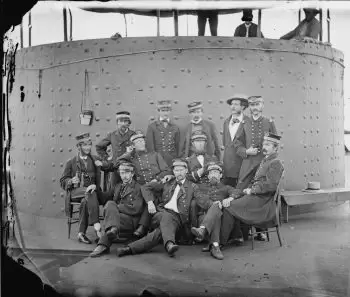
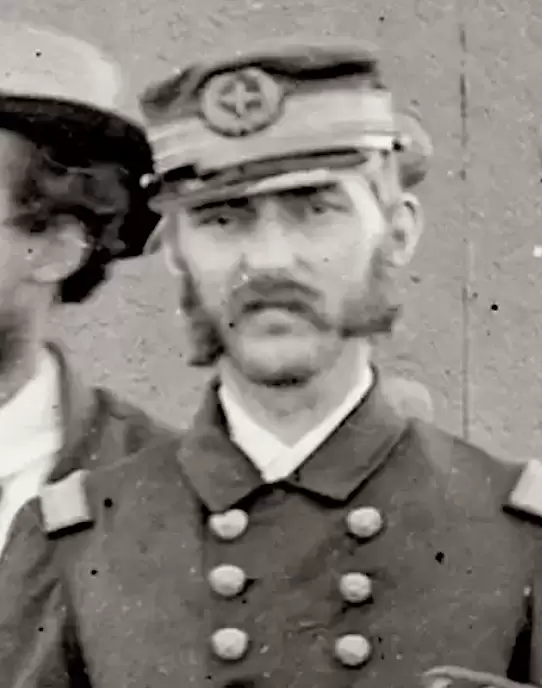
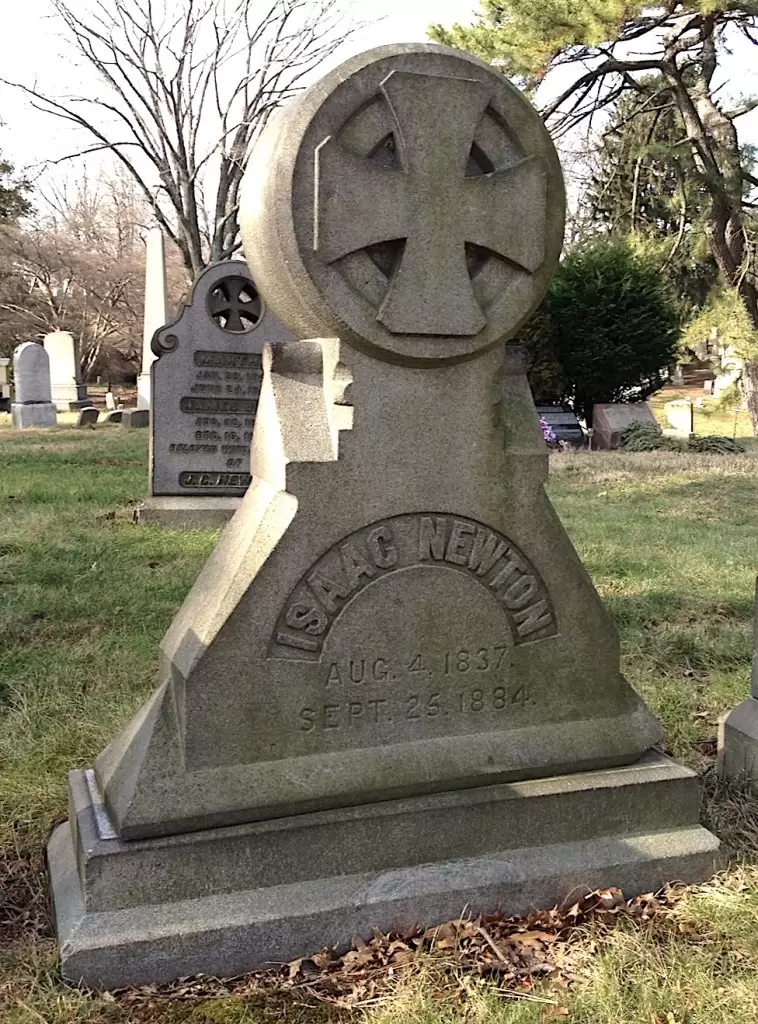
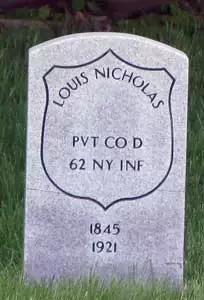
NICHOLAS, LOUIS (1845-1921). Private, 62nd New York Infantry, Company D. Born in Germany, Nicholas enlisted and mustered into the 62nd New York as a private on April 19, 1865. He mustered out with his company on August 30, 1865, at Fort Schuyler, New York Harbor.
Nicholas is listed as a barber in the New York City Directories for 1877, 1884, 1888, 1891 and 1892. The 1880 census shows that he lived with his wife and two young children in New York City. At the time of the New York State census for 1905, the 1910 census and the 1915 New York State census, he was listed as retired and living in Manhattan. The 1920 census indicates that he lived with his son in Brooklyn. His death certificate notes that he was a widower and a retired barber. As per his obituary in the Brooklyn Daily Eagle, his funeral was held at the Church of the Holy Innocence at Beverly Road and East 17th Street in Brooklyn. He died at the home of his son at 394 Argyle Road in Brooklyn. Section 2, lot 5499, grave 409.
NICHOLS, WILLIAM AUGUSTUS (1838-1890). Captain, 151st Indiana Infantry, Company C; second lieutenant, 49th Massachusetts Infantry, Company I; private, 7th Regiment, New York State National Guard, Company A. Nichols was born in Bridgeport, Connecticut. A carriage maker by trade, he enlisted as a private on May 25, 1862, and mustered into the 7th New York Regiment’s National Guard. After he was discharged on September 5, he re-enlisted as a second lieutenant on October 28, and mustered into Company I of the 49th Massachusetts (where he resided in Williamstown). He was wounded on June 14, 1863, at Port Hudson, Louisiana, and mustered out on September 1, 1863, at Pittsfield, Massachusetts. He moved to Peru, Indiana, and on February 25, 1865, enlisted in the 151st Indiana Infantry, was commissioned into Company C as a captain on March 1, and mustered out on September 19 at Nashville, Tennessee.
The 1878 Brooklyn Directory lists Nichols as a clerk at 29 Madison Street. According to the 1880 census, he was living in Brooklyn with his wife and children and was a salesman of ornamental iron goods. He applied for and was granted an invalid pension in 1880, certificate 235,160. The 1889 Brooklyn Directory lists him as a clerk whose home address was 254 Madison Street. As per his obituary in the Brooklyn Daily Eagle, he worked for J. L. Mott Iron Works on Beekman Street in Manhattan. He was a member of several fraternal benefit societies including the Order of Tonti, United Order of Workmen and the National Provident Union. In addition, he was a pew holder at the Central Congregational Church on Hancock Street in Brooklyn and a member of the 23rd Ward’s Republican Association. He last lived in Brooklyn at 254 Madison Street. His obituary notes that he took ill on his way to work and was diagnosed with pneumonia which shortly thereafter resulted in heart failure. His widow confirmed his Civil War service on the 1890 Veterans Census. Mary Jane Nichols, who is interred with him, applied for and received a widow’s pension in 1890, certificate 730,014. Section 200, lot 26956.
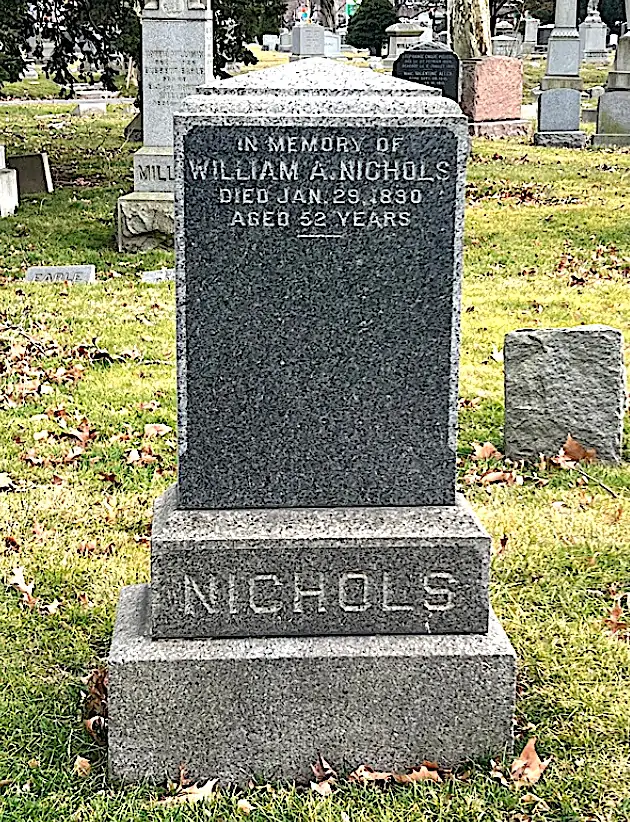
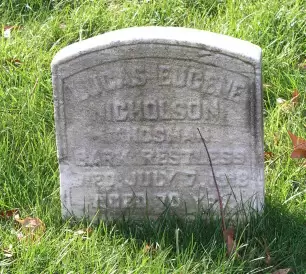
NICHOLSON, LUCAS EUGENE (1848-1918). Landsman, United States Navy. Nicholson was born in New York City. After Nicholson enlisted as a landsman and mustered into the United States Navy on August 18, 1864, he served on the crew of the USS Ohio. He mustered out on June 15, 1865, at Boston, Massachusetts, then served as a tugboat captain aboard his own boat.
The 1885 Brooklyn Directory lists Nicholson as a shipmaster who lived at 497 Clinton Street; the 1890 Brooklyn Directory indicates that he was a captain living at the same address. The 1900 census shows Nicholson as married, living in Brooklyn and employed as a steamboat master. As per the 1902 Brooklyn Directory, he was a pilot who lived at 373 7th Street. The 1915 New York State census reports that he lived in Brooklyn and worked at the Navy Yard. According to his obituary in the Brooklyn Standard Union, which confirms his Civil War service, Nicholson was a member of the police force at the Brooklyn Navy Yard for ten years. At some point, Nicholson applied for and received a pension from the Navy, certificate 32,978. He was a member of the Ulysses S. Grant Post #327 of the G.A.R. A Freemason, he was a life member of the Joppa Lodge and a member of Masonic Veterans; comrades were invited to attend his funeral. He last lived at 330 Rutland Road, Brooklyn. Nicholson’s death was attributed to acute intestinal trouble.
Although his obituaries in the Brooklyn Daily Eagle and the Brooklyn Standard Union indicate burial at Evergreens Cemetery, that is incorrect. He was interred at Green-Wood on July 11, 1918, three days after his death. His G.A.R. sketchbook first recorded his burial place as Evergreens Cemetery; that was then crossed out and replaced with Green-Wood Cemetery. Addie Nicholson applied for and received a widow’s pension, certificate 858,610. His government-issued stone from the early twentieth century confirms his Civil War service. Section 3, lot 21025, grave 212.
NICOLL, GEORGE B. (1845-1917). Corporal, 48th New York Infantry, Company H. Nicoll, a Brooklyn native, enlisted there on February 27, 1864, and immediately mustered into the 48th New York. As per his muster roll, Nicoll was a brass finisher who was 5′ 4″ tall with gray eyes, brown hair and a light complexion. He mustered out with his company with the rank of corporal (promotion date unknown) on September 1, 1865, at Raleigh, North Carolina.
The 1880 census reports that Nicoll was living in Brooklyn with his wife and children and working as a brass finisher; he was listed as a brass finisher in the 1885 Brooklyn Directory. In 1902, Nicoll’s application for a pension was approved, certificate 1,144,348. The 1910 census indicates that Nicoll was a brass finisher at a foundry. According to his obituary in the Brooklyn Daily Eagle, he was a member of James H. Perry Post #89 of the G.A.R.; members were invited to attend his funeral at the home of his daughter, Annie Fitzgerald, with whom he lived at 521 72nd Street in Brooklyn. Nicoll’s death certificate indicates that he was retired and was a widower. As per a petition filed by his daughter at Kings County Surrogate’s Court, he was survived by three sons and two daughters, owned no real estate and had a personal estate valued under $5,500. Section 184, lot 19018.
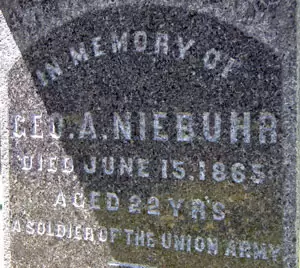
NIEBUHR (or NEIBUHR), GEORGE A. (1843-1865). Corporal, 146th New York Infantry, Company E; private, 5th New York Infantry, Company A. Niebuhr was born in New York. As per the 1860 census, he lived with his parents and siblings in Hudson City, New Jersey, and was employed as a clerk. During the Civil War, he enlisted on July 5, 1861, and mustered into the 5th New York on that date. He was wounded at Second Bull Run, Virginia, on August 30, 1862, hospitalized at the General Hospital in Philadelphia, Pennsylvania, from which he deserted on November 11, 1862, and returned to his regiment on April 10, 1863. After his transfer to the 146th New York on May 4, 1863, he was promoted to corporal on an unspecified date, and is recorded in military records as having deserted at Leesburg, Virginia, on June 26, 1863. However, the notation of desertion may be an error because Niebuhr was listed as a private, after this date, in the Unassigned Veteran Reserve Corps (no details on that assignment). He died from consumption in Hudson City, New Jersey, on June 15, 1865. Section 163, lot 15650, grave 12.
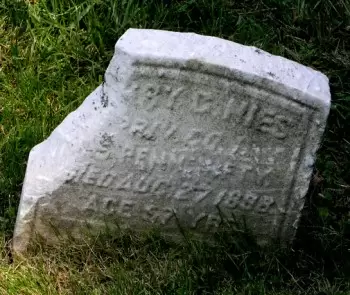
NIES (or NEIS), HENRY (1841-1898). Musician, 52nd Pennsylvania Infantry, Company I. Although newspaper records and his death certificate indicate a birth year of 1841, another source states that Nies was born in 1846. Nies, a native of Pottsville, Pennsylvania, is identified as Henry Neis on his soldier record. A resident of Luzerne County, Pennsylvania, he enlisted as a musician on September 23, 1861, and mustered immediately into Company I of the 52nd Pennsylvania Infantry. One record notes that he first served as a drummer with Captain Henry Jenk’s Company. The 52nd saw service at Baltimore where they were met by an angry mob that pelted them with stones before the 52nd was able to proceed to Washington, D.C. The 52nd was at New Bern, North Carolina, in 1863. Nies mustered out on November 5, 1864.
According to the 1870 census, Nies lived with his parents in Pottsville, Pennsylvania, and worked as a painter. He married Elizabeth (Bessie) Monsey in Scranton, Pennsylvania, at the Scranton Baptist Church on March 24, 1877. The 1880 census lists him as Calvin Nies, a painter from Scranton, Pennsylvania, who was married with children. Nies is listed as a painter in the Scranton City Directory for 1881. In 1890, he applied for an invalid pension, using the name Henry Nies, application 787,845, but it was never certified.
At the end of his life, he owned a shooting gallery in Coney Island. The circumstances of his death, which occurred at that shooting gallery, attracted much attention in the press; he was referred to as Calvin Neis in the articles. A story in the Brooklyn Daily Eagle on August 28, 1898, reported that Calvin Neis was near death in Kings County Hospital after being shot near his heart by a customer at his shooting range at the Sea Beach Palace in Coney Island. As per that article, the customer, who had paid five cents for three shots, struck Neis on the second shot after the rifle had been reloaded with .42 caliber bullets; once Neis fell wounded, the shooter fled the scene. The aforementioned incident took place at around 11:00 p.m.
A subsequent article in the Brooklyn Daily Eagle added more intrigue to Neis’s death. A couple, the Taylors, went to the police station on the night of the shooting claiming that their son had run away from home weeks before and was employed by Neis; the parents insisted that their son return home with them or Mrs. Taylor would do “something desperate.” Coincidentally, a reporter then accompanied the Taylors to the shooting gallery but Neis had already been shot. The Taylors were not suspected of any wrongdoing. The mystery was shortly resolved on August 31, 1898, when the Brooklyn Daily Eagle reported that Henry Auderlidt, a nineteen-year-old from the Bronx, who worked at the shooting gallery, surrendered himself. Accompanied by his mother, Auderlidt confessed that he was cleaning the rifles when one accidentally went off and killed Neis; Auderlidt was released.
Although Green-Wood records indicate that he last resided at 496 Seventh Avenue in Brooklyn, the Brooklyn Daily Eagle noted that he was living at the Oceanic House on West 8th Street in Coney Island. Shortly after his death, Bessie Nies, who is interred with him, applied for and received a widow’s pension based on his Civil War service, certificate 500,184. In 1904, after Bessie’s death, Samuel B. Tilton, an uncle of the Nies’s four children, applied as a guardian for a minor’s pension, certificate 574,656. Section 135, lot 30010, grave 505.
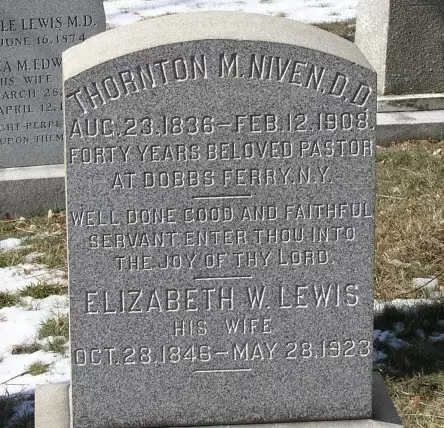
NIVEN, THORNTON McNESS (1836-1908). Chaplain, 13th Virginia Battalion Light Artillery, Company A; private, 1st Virginia Howitzers Light Artillery, Confederate States of America. Niven was born in Newburgh, New York, and enlisted in the Confederate Army as a private (date unknown). After serving in the 1st Virginia Howitzer’s Light Artillery, he transferred into the 13th Virginia on August 15, 1862, was promoted to chaplain on February 26, 1863, and resigned from service on September 29, 1863.
After the War, Niven became a Presbyterian minister; his gravestone indicates that he had a degree as a doctor of divinity and that he was “beloved pastor” at Dobbs Ferry, New York, for 40 years. He died of a cerebral hemorrhage. His daughter, Isabella Thornton Niven, was a poet and the mother of playwright Thornton Niven Wilder. The first woman elected to public office in Hamden, Connecticut, in 1920, Thornton Wilder said his mother was, “like one of Shakespeare’s girls—a star danced and under it I was born.” Section 92, lot 1112.
NIXON, EDWARD (1839-1899). Private, 139th New York Infantry, Company D. Originally from Ireland, Nixon enlisted as a private at Brooklyn on August 27, 1862, and mustered into the 139th New York on September 9. He mustered out on June 19, 1865, at Richmond, Virginia. On June 1, 1898, he was admitted to the Soldiers’ Home in Bath, New York. At that time, he was 5′ 8½” tall plumber with blue eyes, gray hair, a dark complexion, and was able to read and write. The records indicate that he was partially deaf and had heart disease as a result of his military service. In addition, he had a son named James who lived at 1569 Atlantic Avenue in Brooklyn. Nixon was discharged from the Soldiers’ Home on January 9, 1899.
The Veterans Schedule of 1890, which confirms his Civil War service, reports that Nixon suffered from a disability: “Dumb Ague.” His application for an invalid pension was approved in 1890, certificate 608,317. He last lived at 160 Virginia Avenue in Jersey City, New Jersey. Nixon’s death was attributed to complications from pneumonia. Originally interred in Section 17, lot 17245, grave 114, his remains were removed from Green-Wood on April 15, 1903.
NIXON (or NICSON), JOHN R. (1825-1862). Corporal, 102nd New York Infantry, Company G. Nixon was born in New York. On September 8, 1850, he married Maria Totten at the Bedford Street Methodist Episcopal Church in New York City. The 1860 New York City Directory lists Nixon as a painter whose home address was 148 Orchard Street. As per his soldier record, which used the name “Nicson,” he enlisted as a private at Rondout, New York, on November 9, 1861, and mustered into Company G of the 102nd New York six days later. He was promoted to corporal at some point before he was discharged for disability on October 29, 1862, from the United States General Hospital on Wolf Street in Alexandria, Virginia. As per his widow’s pension application, Nixon’s discharge was due to chronic rheumatism and dyspepsia. His last residence was at 184 Orchard Street in Manhattan where he died from diarrhea. Maria Nixon, who is interred with him, applied for and received a widow’s pension on December 10, 1862, certificate 94,850. Mrs. Nixon’s pension application correctly states that John Nixon was in the 102nd New York; the pension index card incorrectly reports that her husband was in the 104th New York. Section 115, lot 4196, grave 900.
NOBLE, GORHAM (or GUSHAM) (1841-1870). Private, 71st Regiment, New York State Militia, Company F. A native of Boston, Massachusetts, Noble was listed as a student of the Pierce Academy in Middleboro, Massachusetts, in 1855; he was a resident of New York City and a student of ancient languages. During the Civil War, he enlisted in 1861 for a period of three months. The New York World reported on June 12, 1861, that Noble was among the privates who set sail on the steamer Mount Vernon for Acquia Creek to determine the best place to land troops; twenty-two men from Company F were on that mission. According to the 71st Regimental history, he was captured at the Battle of First Bull Run, Virginia, on July 21, 1861, and imprisoned at Richmond, Virginia, until January 3, 1862. Upon the intercession of Dr. Peters, the surgeon at the Fort Warren, Massachusetts, Noble was released as part of a prisoner exchange for United States Navy defectors to the Confederacy imprisoned at Fort Warren. The New York World reported on the release of the prisoners on January 6, 1862, noting that the steamboat George Washington picked up the released prisoners, described “as happy-looking as seldom seen,” from the steamer Northampton about nine miles past Newport News, Virginia. In all, 240 men were released, most of whom had been captured at Bull Run. The 4th Artillery band greeted the newly freed soldiers with “Home, Sweet Home” and comrades gathered with shouts of welcome.
Noble is listed as a clerk on his 1863 Draft Registration and in the 1863 Brooklyn Directory. He married Elizabeth Meeker on May 26, 1864. Noble’s 1867 passport application describes him as 5′ 11″ tall with a small nose, light blue eyes, small mouth, round chin, brown hair, fair complexion, medium forehead and oval face. The Brooklyn Daily Eagle reported on April 23, 1869, that Noble was selling a two-story frame house on Grove Street with a tin roof, gas and water, nine rooms, stable and six lots for $9,500. He last lived on Grove Street, Brooklyn. As per his obituary in the Brooklyn Daily Eagle, his funeral took place at the home of his father-in-law, S. M. Meeker, at the corner of Bushwick Avenue and Linden Street in Brooklyn. On July 20, 1870, Meeker filed Noble’s will in Kings County Surrogate Court on behalf of the widow, Elizabeth Noble, for Gorham Noble’s estate valued at $70,000 ($1,260,000 in 2017 money); the couple had no children. Section 9, lot 19468.
NOBLES, MILTON (or TAISEY, MILTON N. or MILTON, TAISEY) (1844-1924). Musician, 11th Wisconsin Infantry, Company F; private, 137th Ohio Infantry, Company B. Born Milton Nobles Taisey, he wrote to his niece, Frances Nelson Tillman on May 29, 1924, shortly before his death, about his early life. Milton was the youngest of four children born to his parents, the Taiseys, in St. Clair, Michigan; his obituaries incorrectly list his birthplace as Cincinnati, Ohio. Nobles’s forbearers were from New England; his parents lived in St. Clair for thirteen years after their marriage in Vermont before settling in Stillwater, Minnesota, in 1847. The Nobles family, including Cal-Bill Nobles, General John C. Fremont’s lieutenant and the namesake of Nobles Pass in the Rocky Mountains, also lived in Minnesota. Listed in his soldier history and his pension index card as Milton Taisey, he enlisted as a musician on September 22, 1861, mustered into the 11th Wisconsin, and was discharged for disability on April 20, 1863. He re-enlisted as a private on May 2, 1864, mustered into the 137th Ohio eight days later, and mustered out on August 19, 1864, at Camp Dennison, Ohio.
As per his obituaries in the Brooklyn Standard Union, The New York Times, the Oswego Daily Times and the Buffalo Courier, he began his acting career in 1867 when he appeared with stock companies in the West. As per a biography by Johnson Briscoe in The Actor’s Birthday Book, Nobles’s experience in stock companies gave him schooling and experience in classic and legitimate roles. Nobles has been described as a Langrishe actor, an homage to John Langrishe, a comedian, actor and impresario who traveled West in the 1850s to pursue his career in the theater. Around 1867, Nobles starred in his own dramatization of “John Bludsoe.” In 1881, Nobles married Dollie (Dolly) Woolwine, a member of his company; the two subsequently appeared together in vaudeville, among the first trained actors to enter that genre.
The History of Hennepin County and the City of Minneapolis, published in 1881, reports that Milton Nobles Taisey left his rural upbringing for “a place behind the footlights” but returned a few years later as the manager of a theatrical troupe as Milton Nobles, having dropped his family name, Taisey. His application to formally change his name to Milton Nobles and that of his wife to Dollie Nobles, was filed and approved in Kings County on January 4, 1884. His obituary in The New York Times notes that he retired from the stage in 1905 but returned in 1920. His application for an invalid pension was granted in 1907, certificate 1,140,428. He last appeared at the Empire Theater in Manhattan the week before his death in the play “She Stoops to Conquer.” His obituaries also note that he had played a role in “Lightnin,” a long-running drama at the Montauk Theater during the last two years of his life.
In addition to acting, he wrote many melodramas among them: “The Phoenix,” “For Revenge Only,” “From Sire to Son,” “For Revenue Only,” and “Love and the Law.” His play, “The Phoenix” was known for the line, “and the villain still pursued her.” In his letter to his niece, he wrote that he had been diagnosed with a bad heart; he confessed that he knew about the condition for ten years but did not take care of himself. He also wrote to his niece that he was looking forward to his performance in “She Stoops to Conquer” and to the publication of three volumes of his works including his “Shop Talks.” His funeral took place at the Church of the Transfiguration, known familiarly as the “Little Church Around the Corner,” on East 29th Street in Manhattan; it was the place of many actors’ funerals. He last lived at 139 1st Place in Brooklyn, his home for more than forty years. His obituary in The New York Times attributed his death to apoplexy.
On June 24, 1924, the Brooklyn Standard Union reported that Dolly Nobles filed for permission to open a safe deposit box after a search of her husband’s effects failed to find a will. Dolly W. Nobles, who is interred with him, received a widow’s pension in 1924, certificate 955,306. On February 22, 1925, Milton Nobles Jr., who is interred with his parents, and who was also an actor, took his own life. Although his mother denied that her son’s death could have been a suicide, articles in the Brooklyn Standard Union and another newspaper reported that the 40 year-old swallowed a bottle of poison on a train from Chester, Pennsylvania, to New York City and had borrowed a pen from a fellow passenger to write a farewell note to his wife. The young man had recently been told that his role in the Baltimore production of “Rose Marie” was being terminated and that might have brought on depression. Section 141, lot 25734.
NODINE, ALONZO (1842-1902). Private, 71st Regiment, New York State Militia, Company H; paymaster’s steward, USS Quaker City. Nodine was born in Norwalk, Connecticut. As per A History of Long Island: From Its Earliest Settlement to the Present Time (Volume 3, 1902) by Peter Ross, his paternal grandfather settled in northwestern Yonkers, known later as Nodine Hill; his father moved to Norwalk where he first was employed as a hatter before engaging in the livery business in 1842, first in Norwalk and then on Pierrepont Street in Brooklyn. Nodine’s obituary in the Brooklyn Daily Eagle reports that he began his higher education at Osborn College in Norwalk but left after a term to attend New York University from which he graduated with a degree in chemistry. He then learned the trade of piano-making which he pursued in the year before his military service. On June 22, 1861, he married Emma Reed at the Methodist Episcopal Church in Manhattan.
As per Peter Ross’s biography of Nodine, he first enlisted in a howitzer corps of the 9th Regiment National Guard, having been promised a lieutenancy. However, he and others went to a saloon in Washington, D.C., where they were poisoned while drinking. After returning to his company, Nodine fell to the ground while marching in that city and was hospitalized for two weeks. He then returned in uniform to the 9th but refused to enter service as a private. In the meantime, the howitzer unit was abandoned and his name never appeared on the rolls of the 9th Regiment. Nodine was then assigned to the 71st New York under Asa Miller (see). Nodine subsequently enlisted in the United States Navy on October 24, 1861, and served as a paymaster’s steward on the USS Quaker City until his discharge on May 8, 1863. The USS Quaker City, built in Philadelphia, was first sent to reinforce Fortress Monroe with munitions, then sent to blockade Chesapeake Bay, dispatched to the Caribbean and Spanish Main before being attached to the Western Gulf Squadron. His older brother, Charles Nodine (see), also served in the Civil War.
After his discharge, Nodine returned to the piano manufacturing business with William Bradbury and invented several improvements. However, due to failing health, he joined his father’s livery business becoming a partner in 1882. The censuses of 1880 and 1900 report that he lived in Brooklyn and worked at a livery stable. After his father’s death in 1894, he became the sole proprietor of the livery business, considered one of finest in New York City. Nodine’s obituary indicates that he was friends with legislative and judicial leaders in his Brooklyn Heights neighborhood. Among the many organizations of which he was a member are the Freemasons and Royal Arch Masons, Knights Templar, Commonwealth Council and the Parkway Driving Club. His death certificate, which incorrectly lists a Brooklyn birthplace, notes that he was married and a livery stable keeper; he had been married for forty-one years and was also survived by two sons. He last resided at 147 Fort Greene Place in Brooklyn. His death was attributed to heart disease and pneumonia.
Emma Nodine applied for and received a pension of $8.00 per month from the Navy in 1905, certificate 23,996. She noted in her pension application that her husband had life insurance of $3,000 from his membership in the Royal Arcanum; that amount was paid to her. She also stated that he owned a vacant lot in Flatbush but that she did not know much about that property; the deed to the lot showed that it was purchased in 1897 for $47.50 and the last tax receipt in 1903 was for 59 cents. Originally interred in lot 8839 on November 13, 1902, his remains were moved to the current location on March 3, 1903. Section 204, lot 31322, grave 2.
NODINE, CHARLES (1840-1886). Private, 11th New York Infantry, Company E. Nodine was born in Connecticut and was the older brother of Alonzo Nodine (see). The 1850 and 1860 censuses report the family as living in New York City; the 1860 census indicates that Charles Nodine was employed as a clerk. After enlisting as a private at New York City on April 20, 1861, he mustered into the 11th New York on May 7, and was discharged for disability on September 1, 1861. Nodine is listed as a clerk on his July 1863 Draft Registration Card.
In the Fifth Annual Report of the Metropolitan Fire Department of New York City (1870), Nodine is listed as a fireman with the Metropolitan Hook and Ladder Company #12. At the time of the 1875 New York State census, Nodine was a boarder with his wife and daughter in New York City and worked in a livery stable. As per the census of 1880, he was a stable keeper living in Brooklyn; the 1886 Brooklyn Directory reports that he worked at the family’s livery business at 156 Pierrepont Street. His obituary in the Brooklyn Daily Eagle noted that newspapers in Norwalk, Connecticut, were asked to print news of Nodine’s death. His last residence was at 116 Henry Street in Brooklyn. His death was attributed to paralysis. In 1910, Mary Nodine, who is interred with him, applied for a widow’s pension, application 935,673, but there is no evidence that it was certified; Charles Nodine’s pension index card incorrectly lists the year of his death as 1887. Section L, lot 18766.
NODINE, JOSEPH (1830-1891). Private, 79th New York Infantry, Company F. Born in New York City, Nodine enlisted there as a private on March 21, 1865, mustered into the 79th New York, and was discharged from military service on July 14, 1865, at Alexandria, Virginia. In 1890, he applied for an invalid pension, application 956,216, but he apparently died before it was certified. Nodine’s last residence was at 222 East 27th Street in Manhattan. His wife applied for and received a widow’s pension after his death from phthisis in 1891, certificate 317,429. Section 116, lot 4073, grave 456.
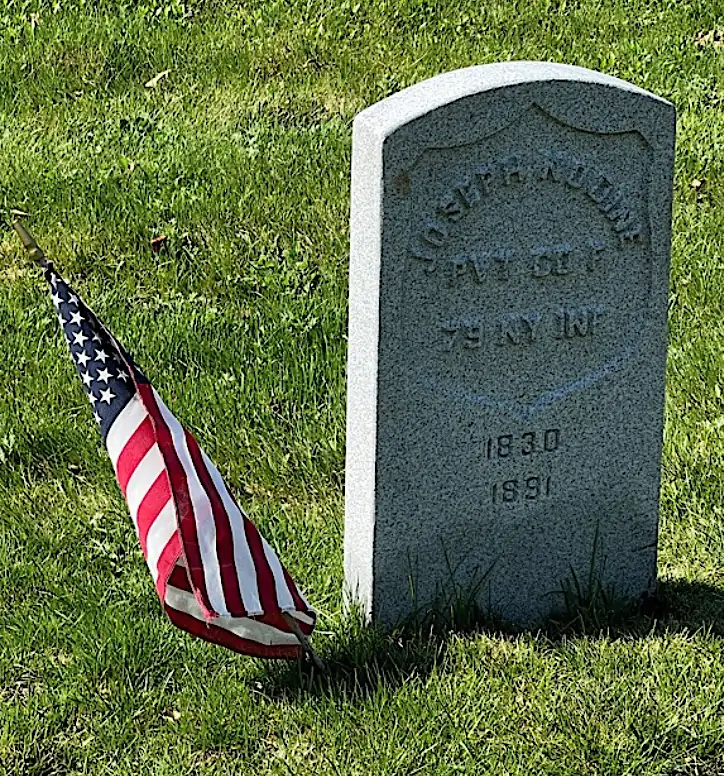
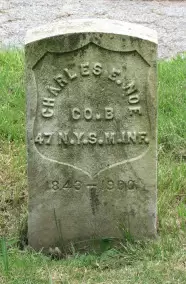
NOE, CHARLES E. (1843-1900). Private, 47th Regiment, New York State National Guard, Company B. Noe’s birth year is uncertain; although his gravestone is inscribed with 1843 and most records support that date, the 1900 census reports that he was born in February 1840. The 1850 census indicates that Noe lived in New York City, his birthplace, with his parents and siblings. At the time of the 1860 census, he still lived in New York City with his parents and six siblings; like his father, Charles Noe was a broker. During the Civil War, he enlisted as a private at Brooklyn on May 27, 1862, mustered into the 47th Regiment, and mustered out after three months on September 1.
The Draft Registration rolls of 1863 indicate that Noe was a clerk; the 1865 New York State census reports that he lived with his parents and siblings and worked as a broker. A newspaper article on June 25, 1881, reported that Noe, intoxicated, fell on the sidewalk at the corner of DeKalb and Tompkins Avenue, suffered a concussion and was treated at Cumberland Hospital. On January 11, 1886, he was admitted to the Kings County Almshouse suffering from syphilis; it was indicated on his paperwork that he “may recover.” Noe’s application for an invalid pension was granted in 1896, certificate 932,156. The 1900 census reports that he was a resident of an almshouse in Brooklyn. His death certificate notes that he was unmarried and worked as a clerk. His last residence was the Glenwood Hotel at 227 Broadway in Brooklyn. He died from phthisis. The application for his government-issued gravestone, filed on June 16, 1936, confirms Noe’s service in the 47th. Section 45, lot 6486, grave 5.
NONNENBACHER, CHRISTIAN (1835-1874). First lieutenant, 6th Regiment, New York State National Guard, Company C. Of German birth, Nonnenbacher immigrated to the United States in 1855. The 1860 census reports that he lived in New York City, worked as a tinsmith, and had a personal estate valued at $200. Nonnenbacher became a naturalized citizen on October 16, 1861; at that time, he lived at 90 Avenue A in New York City. During the Civil War, he enlisted on June 22, 1863, at New York City, and was commissioned into the 6th New York, known familiarly as the Governor’s Guard, that same day. The 6th was sent to Washington, D.C., and was stationed at Annapolis, Maryland, before mustering out after 30 days on July 22 at New York City.
On August 5, 1866, Nonnenbacher married Elizabeth Reitzner of East Chester, New York. He is listed as a tinsmith in the 1868 New York City Directory; he still lived at the 90 Avenue A address. The 1870 census lists him as married with two children, having a tinsmith store and a personal estate of $3,000. The New York City Directories for 1872 and 1874 report that he was in the hardware business at 94 Avenue A. Nonnenbacher’s application for an invalid pension was approved in 1891, certificate 389,783. He last lived in Westchester, New York. Elizabeth Nonnenbacher, applied for and received a widow’s pension in 1891, certificate 389,780. Section 167, lot 16679.
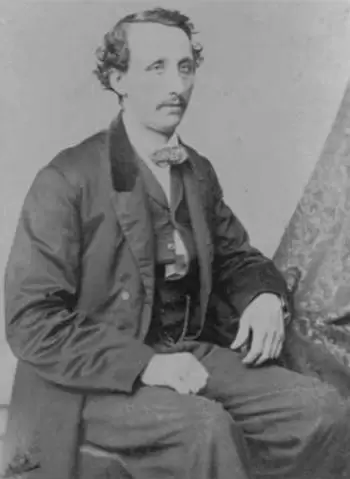
NOON, JAMES (1821-1866). Private, 173rd New York Infantry, Company E; 3rd Infantry, Veteran Reserve Corps, Company H. Of English origin, Noon enlisted as a private at Brooklyn on September 10, 1862, and mustered into the 173rd New York on October 30. He transferred into the 3rd Infantry of the Veteran Reserve Corps on March 16, 1864, and was discharged on July 8, 1865, at Hartford, Connecticut. He last lived at 96 Nelson Street in Brooklyn where he died from cholera. Section 127, lot 8899, grave 115.
NORCOM, JOSEPH (1832-1914). Captain, 4th Battalion, Washington Artillery, Louisiana, Confederate States of America. Born on a plantation in North Carolina and a clerk by trade, Norcom began service in the Confederate Army when he enlisted as a junior first lieutenant on May 26, 1861, at New Orleans, Louisiana, and mustered into the 4th Battalion, Washington Artillery, Louisiana, rated as one of the best units of the Confederacy. A report by the 4th Battalion’s Major J. B. Walton, written from Bull Run, Virginia, on July 22, 1861, stated that Norcom was in command of a six-pound howitzer under General Jones’ Third Brigade at McLean’s Ford.
Promoted to captain dating from March 1862, Norcom was on recruiting duty in January-February of that year in New Orleans and again in January-February of 1863. On May 3, 1863, he led the 4th, on the left of the Washington Artillery, at Marye’s Heights, Fredericksburg, where he helped hold off General Sedgwick as he tried to join General Hooker at Chancellorsville, Virginia. At the Battle of Gettysburg, Pennsylvania, where he suffered a contusion wound on July 3, 1863, he led his company with 12-pound Napoleons. His name appears on a Confederate Monument at Gettysburg noting the 4th’s position under General Longstreet on July 3 in the peach orchard. On May 16, 1864, he manned guns at Drewry’s Bluff, Virginia. Late in 1864 he was stationed at Petersburg, Virginia, as part of the artillery attached to the Third Corps. After relocating to New York, he worked as a stock broker, was a member of the Confederate Veterans’ Association of New York, and also belonged to the Royal Arcanum of Brooklyn where he was a past regent. His last address was 103 Gates Avenue in Brooklyn. He died of heart disease. Section 6, lot 22278, grave 3.
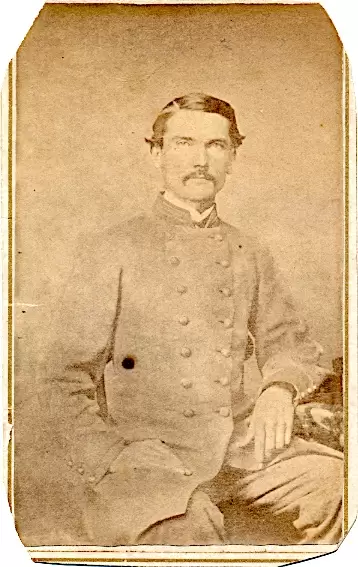
NORRIS, CHARLES THOMAS (1844-1903). Private, 84th New York (14th Brooklyn) Infantry, Company H. Norris was born in New Orleans, Louisiana. The 1850 census and the 1855 New York State census report that the family was living in New York City; Charles Norris’s father was listed as a pilot. During the Civil War, Norris enlisted as a private on April 18, 1861, and mustered into the 14th on May 23; his captain was William H. DeBevoise (see). As per his muster roll, he was a clerk who was 5′ 9½” tall with blue eyes, dark hair and a dark complexion. His muster roll indicates that he was detailed as a clerk to the Adjutant General’s Office in April 1863. He played on the 14th Brooklyn’s baseball team. Norris was discharged on March 13, 1864, at Washington, D.C., by Special Order of the Secretary of War.
As per the 1865 New York State census, Norris worked as an accountant. The 1875 New York State census and the 1880 census report that he lived in Brooklyn with his wife and children and worked as a bookkeeper. He applied for and received an invalid pension in 1903, seven months before his death, certificate 1,059,805. As per his death certificate, he was married and worked as a salesman. His last residence was 49 Monroe Street in Brooklyn. His death was caused by apoplexy. Shortly after his death in 1903, Louise Norris, who is interred with him, filed for a widow’s pension, application 789,456, but she died before it was certified. Section 80, lot 10537, grave 5.
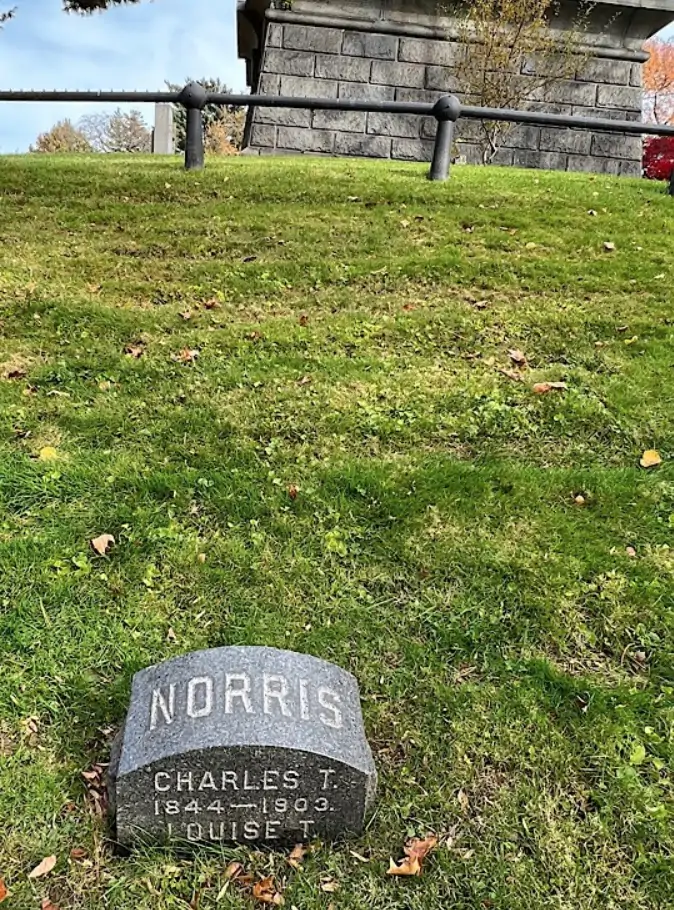
NORRIS, JR., HENRY DOLE (1844-1917). Commissary clerk, Union Army. A native of New York City, he was a chief commissary clerk in the Union Army from 1863 through 1865. According to his obituary in The New York Times, he was attached to the headquarters of General George A. Thomas in Nashville, Tennessee. After the War, he used his experience to begin a provisions business that he continued until 1878. He then founded Thompson & Norris, an enterprise specializing in corrugated paper and granulated cork on Concord and Prince Streets in Brooklyn.
Norris was a pioneer in the manufacture of corrugated paper that was invented in 1875 and expanded the initial Brooklyn business to plants around the U.S. (New Jersey, Boston and Brookville, Indiana); Canada (Niagara Falls and Montreal); and Europe (London, Paris, and Yulich, Germany). Norris’s plant supplied most of the corrugated paper in the United States. Active in many organizations, he belonged to the Manhattan Athletic Club, the Montauk Club, and the Brooklyn Marine and Field Club. In addition, he belonged to the New York and Columbia Yacht Clubs and the Algonquin Club in Boston. He last lived at 15 West 74th Street in Manhattan but died from diabetes at his summer home in Rockland, Maine. Section 118, lot 32743.
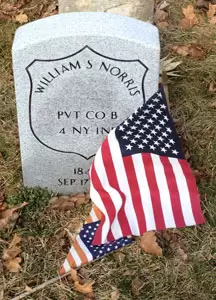
NORRIS, WILLIAM S. (or L.) (1840-1862). Corporal, 4th New York Infantry, Company B. A native New Yorker, he enlisted as a corporal on April 22, 1861, at New York City, and mustered into the 4th New York on May 9. He was reduced to the rank of private on August 5, 1861, and was killed at the Battle of Antietam, Maryland, on September 17, 1862. A marble Veterans Administration stone was ordered for him early in the 20th century. Section 115, lot 13536 (Soldiers’ Lot), grave 52.
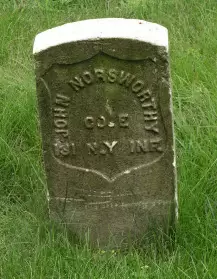
NORSWORTHY, JOHN (1847-1929). Private, 131st New York Infantry, Company E. Norsworthy was born in Newfoundland, Canada. The census of 1900 reports that he immigrated to the United States in 1860. After he enlisted as a private at New York City on February 15, 1864, he mustered immediately into the 131st New York. According to his muster roll, he was a plumber who was 5′ ½” tall with brown hair, brown eyes and a dark complexion. Norsworthy mustered out with his company at Savannah, Georgia, on July 26, 1865.
According to the census of 1880, he lived in Brooklyn with his sister and worked as an emery polisher. In 1892, he applied for and received an invalid pension, certificate 967,817. His pension index card, which notes the alias “John N. Collins,” indicates that he also served in the United States Navy and lists the following vessels upon which he served: USS Vermont, USS Franklin, USS Ticonderoga, USS Ohio, USS Macedonian, USS Potomac, USS Miantonomoh, and USS Narragansett.
The 1899 Register of Civil, Military, and Naval Service lists Norsworthy as a first class painter appointed to the Brooklyn Navy Yard. The 1900 census reports that he lived in Brooklyn with his wife and worked as a ship painter. The 1907 Brooklyn Directory reports that he was a painter who lived at 9 East 3rd Street in Brooklyn; the 1910 census and the 1915 New York State census show that he lived in Brooklyn and was a painter at the Navy Yard. As per his death certificate, he was married and worked as a painter. He last lived at 310 Vanderbilt Street in Brooklyn. His death was attributed to heart disease. Sarah Norsworthy, who is interred with him, applied for and received a widow’s pension in 1930, certificate A-11-7-30. On January 9, 1930, Sarah Norsworthy applied for a government-issued headstone citing her husband’s service in the 131st New York during the Civil War. Section 59, lot 6631, grave 12.
NORTHOVER, JOHN (1822-1869). Corporal, 95th New York Infantry, Company H. A native of England, Northover enlisted as a corporal at New York City on October 11, 1861, and mustered into the 95th on November 8. He was wounded in the left leg at Gettysburg, Pennsylvania, on July 1, 1863, a battle that was devastating to the 95th: it lost 115 in killed, wounded or missing. On July 6, 1863, the New York Herald listed Northover as one of the casualties of the Fifth Corps, to which the 95th had been assigned. He was discharged for wounds on December 12, 1863. On January 7, 1864, his application for an invalid pension was approved, certificate 28,799. As per his death certificate, he was unmarried and worked as a carman. Northover’s last residence was at 203 West 19thStreet in New York City. The cause of his death was an aortic aneurysm. His remains were moved to its current location on September 27, 1871. Section 188, lot 19592, grave 313.
NORTON, EDWARD E. (1845-1910). Artificer, 1st Battalion Engineers, United States Army. Originally from Maine, Norton enlisted as a private on January 21, 1864, and mustered into the 1st Battalion Engineers of the United States Army. He was promoted to artificer before he mustered out on January 21, 1867. The 1865 and 1870 censuses note that he lived in Brooklyn; the 1870 census reports that he was a tinsmith. The 1890 Veterans Schedule confirms Norton’s Civil War service.
As per the Directory of Morristown, New Jersey, in 1899, Norton was in the hardware business. In 1902, his application for an invalid pension was approved, certificate 1,072,148. The Courier-News of Bridgewater, New Jersey, reported on April 26, 1909, that Norton’s hardware store was burglarized for the third time in five years; revolvers, pocket knives and razors worth $100 were taken but the cash register was untouched. The Business Directory for Summit, New Jersey, in 1909 lists Norton’s hardware business at 410 Springfield Avenue. According to the 1910 census, he was living in Summit, New Jersey, and was a hardware merchant. As per his obituary in the Chatham Press [New Jersey], which confirms his Civil War service, he last lived at 38 Mountain Avenue in Summit, New Jersey. His death was attributed to chronic endocarditis. Agnes Norton applied for a widow’s pension in 1911 that was granted under certificate 725,120. Section 150, lot 11755.
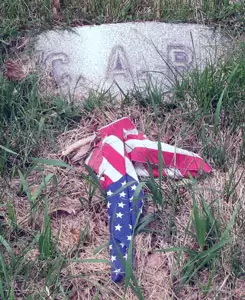
NORTON, MICHAEL (1840-1907). Sergeant, 162nd New York Infantry, Company I. Of Irish origin, Norton enlisted as a sergeant at New York City on September 4, 1862, and mustered into the 162nd New York on October 18. According to his muster roll, he was a blindmaker who was 5′ 6″ tall with blue eyes, sandy hair and a fair complexion. Norton’s muster roll reports that he was absent and sick at the United States Barrack Hospital at New Orleans, Louisiana, on October 31, 1863, and returned to his regiment in April 1864. He was reduced in rank to private on April 10, 1864. Norton was detached to the 1st Division 19th Ambulance Corps, on February 1865, returned to his company in June 1865, and mustered out on October 12, 1865, at Savannah, Georgia.
His application for an invalid pension was granted in 1890, certificate 756,866. Norton was a member of the Engineers’ Association. As per his death certificate, he was married and employed as a ship joiner (a craftsperson who constructs the woodwork on a ship). His obituary in the Brooklyn Standard Union noted that he died suddenly from heart trouble; that obituary also indicated that he had lived for fifty-eight years in Brooklyn and had worked at the Navy Yard for many years. His membership in the G.A.R. is inscribed on his gravestone. He last lived at 628 72nd Street in Brooklyn. Lydia C. Norton, who is interred with him, had previously applied for and received a widow’s pension in 1878, certificate 214,096, after the death of her previous husband, Chester Stickles, who had served in Company I of the 91st New York Infantry. Lydia married Norton on May 11, 1905; a notation about Lydia Sickles receipt of a widow’s pension appears on Michael Norton’s pension index card. Section 133, lot 16874, grave 130.
NORTON, NORRIS RANDALL (1835-1870). Captain, 5th Ohio Cavalry, Company K. A Pittsburgh, Pennsylvania, native, Norton was associated with the press in Cincinnati, Ohio, prior to his military service. According to his obituary in the Cincinnati Daily Enquirer, he came to that city in 1851 and worked for the Columbian, the Gazette, the Enquirer, and the Penny Press; he also contributed poetry to the Cincinnati Daily Press. During the Civil War, he enlisted as a captain on September 26, 1861, the same day that he was commissioned into Company K of the 5th Ohio Cavalry. On April 5, 1862, he was wounded in action near Newalla, Mississippi; his obituary in the Chicago Tribune, which notes that he served with distinction, confirms that he was seriously wounded and refers to the site as the Battle of Corinth. His obituary in The New York Times reports that he was also injured in the foot during one of his encounters with “the guerillas of West Tennessee” and was disabled for many months; the Cincinnati Daily Enquirer notes that he was injured at Shiloh, Tennessee. He resigned his commission and was discharged on account of his wounds on April 12, 1863.
The 1863 Cincinnati Directory lists him as a journalist. His song, Emblem of Freedom, published in Cincinnati for the Benefit of the Great Western Sanitary Fair and printed in Perrysburg [Ohio] Journal on August 12, 1863, begins, “Can the traitors yet hope that the flag they have torn will not peacefully float o’er the Nation again; That the banner their sires have successfully borne unavenged can be trod in the dust of the plain?…” The final stanza of his tribute to Union flag ends with these lines: “…Let us strike till that Banner of Beauty again over every fair state of the Union shall wave….”
Norton came to New York City after the Civil War and worked as assistant editor for the Tribune; he was disabled by sciatica and needed crutches to walk. He left that job for a position as the chief clerk in the Bureau of Sanitary Inspection. The 1868 New York City Directory states that he was a clerk who lived at 218 West 18th Street. His obituary in The New York Times reports that he was an expert on the problems of overcrowding in tenement houses and that his essays were included in the annual reports of the Board of Health. Esteemed by friends and colleagues, he was lauded for “his rare ability as a writer.” The Sacramento Daily Press posted his obituary and indicated his service as a news journalist as well as his military service. His obituary in the New York Tribune, which also lauded his Civil War service, referred to him as an “honorable, generous, and chivalrous gentleman…” At the time of his death, he was the chief clerk at the Board of Health. His death certificate lists him as a clerk, but misspells his first name as Honis. His wife, Sarah Frances Norton, who devoted her life to philanthropy, was the great grand-daughter of President John Adams. His last address was 60 Perry Street in Manhattan. His death was attributed to Bright’s disease and peritonitis.
Sarah Norton applied for and was granted a widow’s pension in 1888, certificate 254,100. When Mrs. Norton died in Troy, New York, in 1910, she was penniless, having exhausted her fortune helping those in poverty. An advocate for the Society of Prevention of Cruelty to Children and Animals, she sought a New York City monument for Henry Bergh, an advocate for animals, who is buried at Green-Wood; she was also a friend of Horace Greeley, and colleague of Henry Ward Beecher (see), and Susan B. Anthony. Section 86, lot 17340, grave 3.
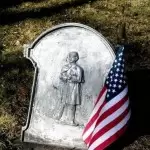
NORTON, THOMAS (1842-1883). Private, 73rd New York Infantry, Company B. A native of Philadelphia, Pennsylvania, Norton enlisted on July 27, 1861, at New York City, and mustered into the 73rd New York on August 20. He was discharged for disability on March 27, 1863, at Convalescent Camp, Virginia. In 1879, his application for an invalid pension was approved, certificate 209,208. As per his death certificate, he was married and employed as a cook. His monument is made from zinc. In 1884, Mary Norton applied for and received a widow’s pension, certificate 306,422. Section 64, lot 11062.

NORVAL (or NORVALL), JAMES (1823-1874). Lieutenant colonel by brevet; surgeon, 79th New York Infantry; 84th Regiment, New York State National Guard. Of Scottish birth, Norval studied medicine at Glasgow University and graduated as a surgeon with the highest honors. After starting his medical practice in Scotland, he immigrated to the United States with his wife and mother aboard the Sarah from Glasgow, arriving in New York City on July 19, 1850. Norval is listed as a physician in the 1857 New York City Directory; his home address at that time was 630 Hudson Street. His home was a red brick-faced brownstone of four stories with a variety store on street level.
During the Civil War, he enlisted as a surgeon on May 9, 1861, at New York City, and was commissioned into the 79th New York’s Field and Staff on June 1; his soldier records list him as James Norvall. During Norval’s service, he was captured in action and exchanged. According to a descendant, he was captured in action at the first major battle of the Civil War, First Bull Run. As per his obituary in the New York Daily Tribune, Norvall “distinguished himself at Bull Run for bravery and devotion to the wounded.” Norval’s biography by the Saint Andrews Society, a benefit society founded by Scottish immigrants, notes that he was paroled by Confederate General Beauregard after the battle and followed the wounded to Richmond to tend to all soldiers in need before he returned to Union lines. He then was appointed staff surgeon at Camp Depot in Annapolis, Maryland. Norval chose to stay in the Army stating his preference to stay with the wounded where he was most needed. On December 7, 1862, The New York Times published “Books for the Paroled Prisoners,” citing Norval’s hope that New Yorkers would help Union soldiers:
On the 20th of July last the camp for paroled prisoners of war was established at Annapolis, Md. Up to the present time thirty thousand of our soldiers, direct from the military prisons of the South, have arrived in this camp–many of them in a pitiable condition–having scant clothing, shattered constitutions, debilitated by fatigue, wounded, and suffering from diseases incidental to the parts they have come from, and reeking with the filth of Southern dungeons. The Government has supplied them with clothing and comfortable quarters, yet disease has carried a large mortality amongst them, and an unusual proportion are inmates of the hospital and confined to quarters.
Dr. JAMES NORVAL, Surgeon of the Seventy-ninth (Highlanders) N.Y.S.M., who has charge of the hospital department, applies himself day and night, with his staff of assistants, to the care of these men, has abundant medical supplies, but feels greatly the want of entertaining and instructive books for the use of the convalescent. The inanity of mind attendant upon this condition cannot be more readily relieved than by reading works of a narrative, humorous or historical nature. He therefore appeals to the citizens of New-York and its publishers for assistance in his efforts to establish a hospital library. There are over two thousand New-Yorkers in Camp Parole, and we feel assured that no New-Yorker will fail in appreciating and assisting Dr. NORVAL in his laudable endeavors.
Packages addressed to JAMES QUEE, Esq., No. 624 Hudson-street, will be duly forwarded to the Librarian, Lieut. HARRIS, author of Prison Life in Richmond.
The New York Times wrote that Norval “applied himself day and night, with his staff of assistants, to the care of these men.” A letter commending Norval was published in the Indianapolis Daily Journal on March 19, 1863, describing a visit to Parole Camp at Annapolis by Isaac W. Monfort, a military agent. Monfort noted that many of the men described harsh treatment and lack of food but he found a bright spot when he visited the hospital, administered by Dr. James Norval. The commendation of Norval, which was part of his report, is below:
Camp Parole Hospital, two miles from the city, is, in all particulars, the best field hospital I have ever visited. It consists of tents with good pine doors and floors, and is kept in the best order, neat and clean. The best of cots are used, and good mattresses. Bed clothes are in abundance, and kept clean.-Each cot is dressed with white sheets and spread.
The storehouse is filled with all that is necessary for the comfort of the sick.
I found here fifty four Indiana soldiers. They were much cheered with a visit from the Agent. Each one was visited as he lay on his cot, and a word of comfort and encouragement spoken. We talked of home, and parents, and friends, until our hearts seemed knit together. To me it was a delightful season and profitable to the sick, so lonely in a land of strangers. I felt very much like staying with them, so delightful did the hours pass.
These hospital tents have paper hangings along the ridge pole, around the square, and in several places overhead, giving to them quite a home-like appearance. Camp Parole Hospital is in charge of Dr. James Norval, of whom our soldiers speak with great favor.
I was requested by Dr. Norval to procure for this hospital a box of magazines, or such reading matter as would be suitable to the wants of the convalescent. Will some of the good friends of your city gather a quantity of magazines for this hospital and send them to this office, free of charge. I start to Fort Schuyler tomorrow to look after some disabled there.
Norval was discharged on June 13, 1863. After re-enlisting as a surgeon at New York City on July 3, 1863, he was commissioned into the Field and Staff of the 84th for 30 days, and mustered out at New York City on August 4, 1863. On July 13, 1864, the New York Daily Tribune reported that Surgeon Norval was among the over 800 men of the 84th National Guard who embarked on the steamer Merrimac en route to Baltimore, Maryland. Returning to the 84th Regiment on August 13, 1864, Norval was commissioned in on that day, and mustered out on October 29, 1864, at New York City.
The 1867 New York City Directory lists Norval as a physician. On November 7, 1867, the New York Tribune printed an ad that urged New Yorkers to vote for Dr. James Norval for coroner asking the “Boys in Blue to give the “Fighting Doctor” of the old 79th N.Y. Volunteers a hearty lift!”; it is unclear if he was elected. His biography, published by the Saint Andrews Society, notes that his health had been compromised and he eventually became a medical consultant, rather than a doctor. That biography notes that Norval was a kind-hearted man who wrote beautiful letters characterized by a sparking wit and left a lasting legacy among Scotsmen in New York City. Keeping up with his interest in the military, Norval, as the Evening Telegram of November 16, 1871, reported, was appointed adjutant of the 79th Regiment. His obituary in the Evening Telegram, which confirms his Civil War service, notes that Norval was well known in the Scottish community in New York City; his obituary in the Evening Telegram requested that his obituary be copied in newspapers in Glasgow, Scotland.
An article about Norval’s funeral in the New York World indicated that his funeral included rites of the Methodist Episcopal Church. His body was accompanied to Green-Wood Cemetery by a police squad from the 9th Precinct, comrades from the 79th Regiment in full dress, members of the Caledonian Club (an organization devoted to culture of Scotland), and fellow Freemasons. Members of the Thistle Benevolent Society, Saint Andrews Society and the Mutual Benefit Society also attended his funeral; these organizations, mainly consisting of professional men, combined socialization and mutual aid. He was buried with military honors and full Masonic rites. His death was attributed to erysipelas. He last lived at 630 Hudson Street in New York City; that building was sold in 1881 and later used as a wholesale liquor warehouse in the early twentieth century; its exterior remains much the same as it has been since renovations in 1881. On August 19, 1888, he was posthumously brevetted lieutenant colonel for “faithful and meritorious service as a surgeon for the 79th.” His descendant has two swords that originally belonged to Norval, one a medical officer sword and the other, a presentation sword given to him by the people of New York City in recognition of his bravery and devotion to the wounded. Section 207, lot 20854.
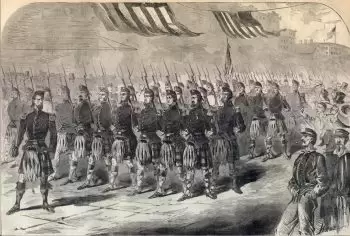
NORWOOD, RICHARD (1827-1866). Drummer and musician, 7th Regiment, New York State Militia and National Guard, Companies B and G. Norwood, who was born in New York, enlisted as a drummer in Company B and served for 30 days with the 7th Militia in 1861. He re-enlisted as a musician at New York City on May 25, 1862, mustered immediately into the 7th Regiment, which was part of the New York State National Guard, and mustered out three months later on September 5 at New York City. As per his death certificate, he died in New York City. Although Matilda Norwood applied for a widow’s pension in 1904, application 804,570, it was never certified. Section 163, lot 14805.
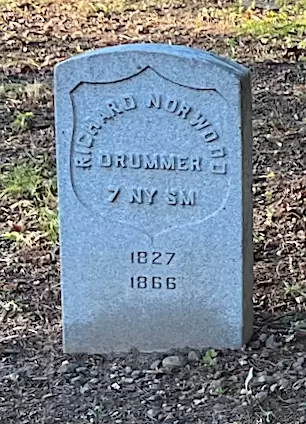
NOWLIN, LEVI (1843?-1925). Private, 36th Ohio Infantry, Company I. The year of Levi’s birth appears to be uncertain. As per the Nowlin-Stone Genealogy; A Record of the Descendants of James Nowlin, Levi was the tenth child of Burwell (“Bird”) and Annie Hall Nowlin. He was born July 1, 1843 in Clay township in Gallia County, Ohio. However, on his passport application in 1921, Levi states his birth date as July 1, 1845. Up until the Civil War, he was a farmer. His ancestors were from Ireland and settled in Pittsylvania County, Virginia, circa 1700. Some family members moved to Kentucky during pioneer days, as per that genealogy.
According to the 1850 census, Levi lived in Clay, Ohio with his parents and siblings: Ellenor (22), James (21), Enos (18), Cynthia (16), Josaphine (14), Charles (11), Andrew (7) and Mariah (2). He still lived in Clay at the time of the 1860 census; three children with the last name of Stewart and an older brother, Andrew, lived with Levi and his parents.
The family genealogy details Levi’s Civil War service. At age 18, Nowlin enlisted as a private on January 8, 1862, in the 36th Ohio Volunteers for three years. When he was wounded in the Battle of Chicamauga, he was left for dead on the battlefield and taken to Richmond as a prisoner. Exchanged after two months, he rejoined his regiment at Winchester, Shenandoah Valley. Once again, he was captured on July 24, 1864, and held at the notoriously horrendous Danville, Virginia, prison camp. On October 6, 1864, he escaped and crossed the Blue Ridge and Allegheny Mountains to the head waters of the Kanawha River at Ganby Bridge (later corrected to Gauley Bridge), near Charleston, West Virginia. It took him one month and four days until he finally reached the safety of federal lines. The Official Roster of the Soldiers of the State of Ohio notes that he mustered out on January 11, 1865. On August 17, 1866, his application for an invalid pension was approved, certificate 80,222.
As per the family genealogy, he married Caroline (Carrie) Wolfe of Racine, Ohio on July 15, 1866; they had three children: Gertrude, who died in infancy; Bertie, who died at age 37, and Edgar. On February 4, 1869, an article appeared in the Gallipolis Journal that Levi and other Nowlins were involved in a lawsuit that sought to restrain them from cutting lumber in a property in Gallia County. In addition, the Nowlins were said to owe $750 on a foreclosed property, plus interest and costs (outcome unknown). On October 29, 1879, the Herald Republican reported that Nowlin had exhibited his produce at the fair in Cass County and was first in squashes and second best in turnips.
At the time of the 1900 census, Levi, Carrie and Edgar lived at 23 Lafayette Avenue in Brooklyn in a rental. One boarder and six roomers were listed as part of the household. The New York State census of 1905 notes that the Nowlins and five lodgers lived in Brooklyn. According to the 1910 census, the Nowlins still resided at the Lafayette Avenue address; Levi was listed as a court attendant at the Municipal Court; a boarder and lodgers were also listed as part of household. Carrie Nowlin’s death was announced in the Brooklyn Eagle on July 7, 1912. At the time, the family still lived on Lafayette Avenue in Brooklyn. The 1913 Brooklyn Directory identified Levi as an attendant living in Brooklyn. The 1915 New York State census showed that he was living in Brooklyn. In 1920, Levi was a passenger on the manifest of the Miami arriving in Key West, Florida on April 1. In February 1921, Levi applied for a passport. He described himself as 74 years old, 6′ 1½” tall with iron gray hair, a moustache, black eyes, bald, straight nose, very high forehead, dark complexion, broad chin and wearing glasses. On that application. he wrote that he spent winters in Santa Barbara, Isle of Pines, and would be traveling to Cuba for property interests.
Nowlin died on February 23, 1925, in Brooklyn. His obituaries in the Brooklyn Citizen and the Times Union, which confirmed his Civil War service in the 36th Ohio Infantry, noted that his funeral was held at George Werst’s Funeral Home at Hart Street and Evergreen Avenue and that he was a Freemason. He was survived by his son Edgar, one sister and one granddaughter. Section J, lot 33682.
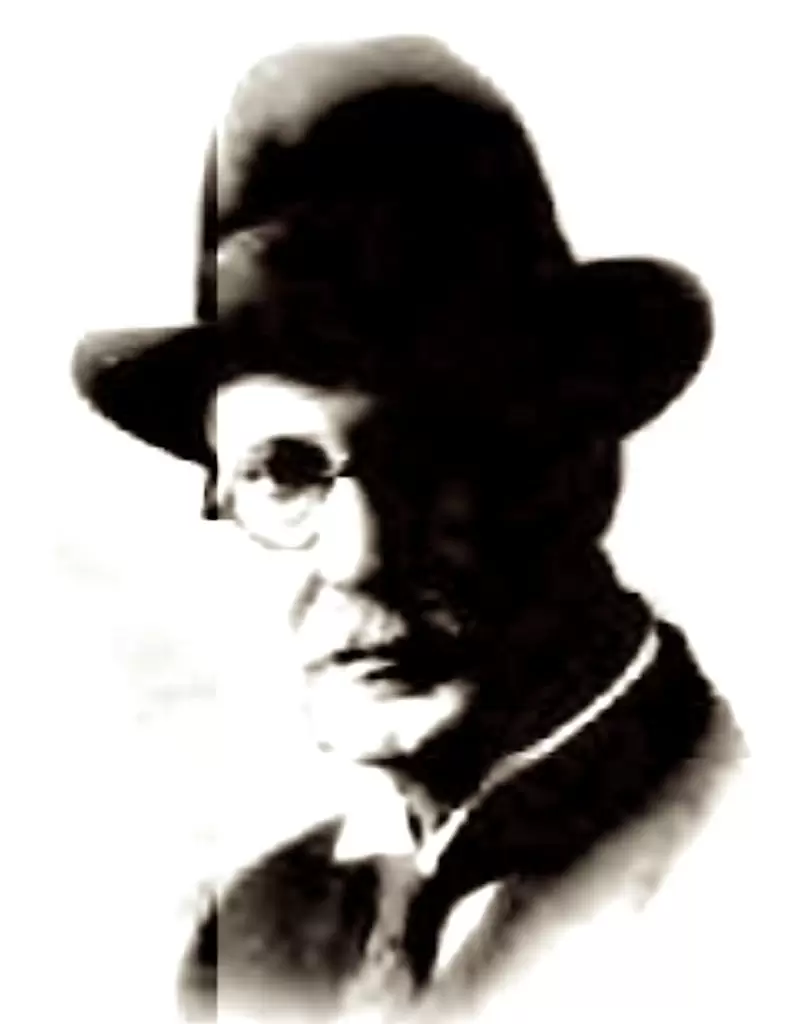
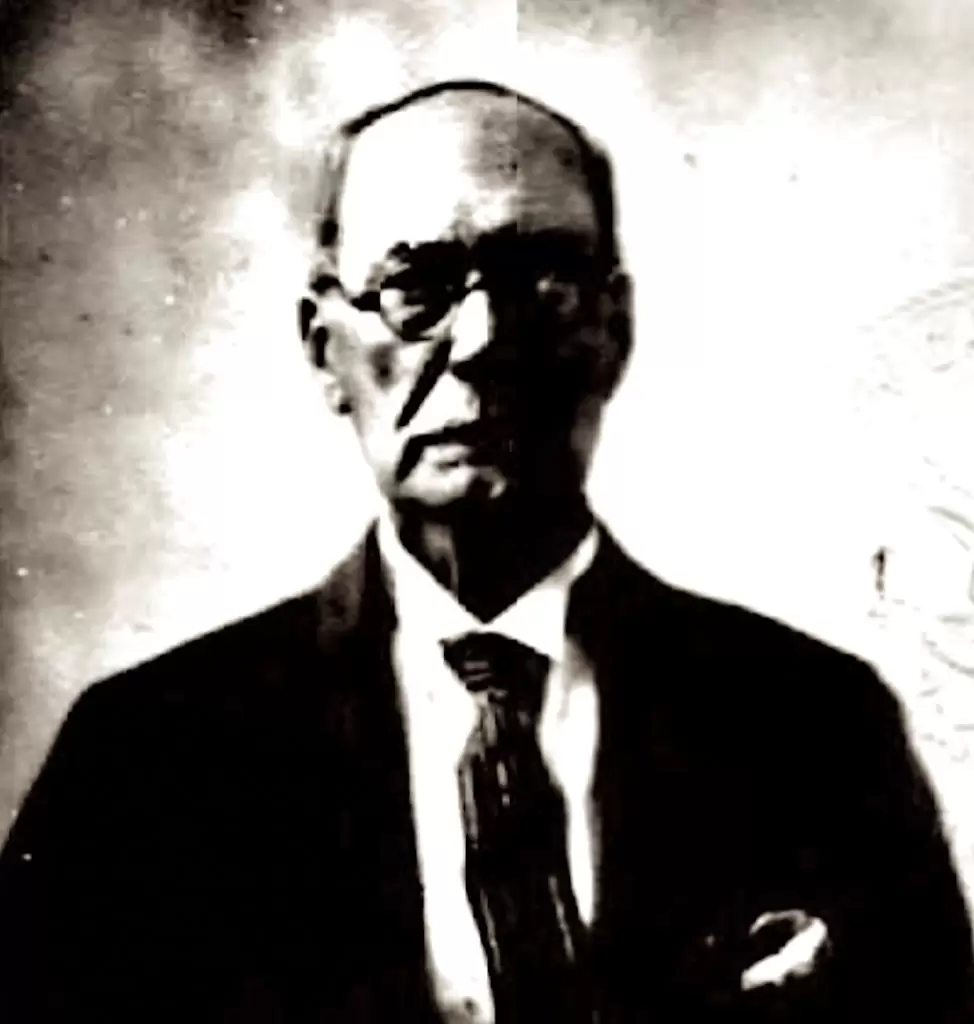
NOYES (or NOYCE), JOSEPH CLARK (1842-1907). Private, 44th Massachusetts Infantry, Company A. A native of Maine, Noyes enlisted at Boston for nine months on August 29, 1862, and mustered into the 44th Massachusetts Infantry at Camp Meigs, Massachusetts, on September 12; his muster roll notes that, though he was already 20 years old, he had received the consent of his parents. He mustered out at Readville, Massachusetts, on June 18, 1863. At muster-out, it was noted that his clothing account was charged $34.43 for an outstanding U.S. canteen and haversack.
As per the 1874 Brooklyn Direction, he was employed as a broker; the 1906 Brooklyn Directory lists him as a broker at the Manhattan Produce Exchange. He was living in Brooklyn at the time of the 1900 census. His application for an invalid pension was approved, certificate 1,140,111. He last lived in Manhattan. In 1909, Lucy Noyes applied for and received a widow’s pension, certificate 681,762. Section 142, lot 22229.
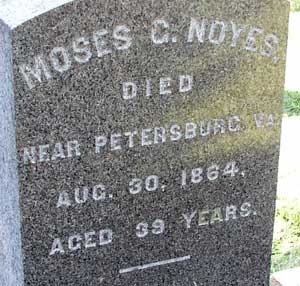
NOYES, MOSES G. (1826-1864). First lieutenant and adjutant, 139th New York Infantry, Company I. Originally from Poultney, Vermont, Noyes married Mary Campbell Skaats in Watertown, New York, on June 6, 1853. The 1857 New York Directory lists him as working in provisions; the 1862 Brooklyn Directory reports that he was a broker. During the Civil War, he enlisted at Brooklyn as a private on August 26, 1862, mustered into the 139th New York on September 9, and was promoted to first lieutenant on August 2, 1864. He died at the hospital at Point of Rocks, Virginia, of chronic diarrhea, on August 30, 1864; his soldier record incorrectly gives the date of death as August 3, 1864. That hospital was on the original site of a plantation house near Chester, Virginia, which became a Union military observation point and headquarters for General Benjamin Butler during the 1864 Bermuda Hundred Campaign.
The surgeon who attended Noyes, A. Burt Jr., noted in Mrs. Noyes’s pension application that he saw Noyes constantly during the last few months of his life because the two shared quarters. Burt reported that Noyes first suffered from diarrhea in July 1864 after returning from detached duty, was excused from duty for a few days, and apparently recovered. He did not visit the hospital or seek treatment at any other time until August 19 when he suffered another acute attack of diarrhea. On August 25, 1864, the regiment began an exhausting march from Petersburg to the James River. Burt and Noyes were together, both suffering from lack of food, sleeping where they could during a night marked by thunderstorms, and both feeling exhausted and sick the next day. Noyes failed to rally and died on August 30, 1864. Noyes was listed on the Roll of Honor of officers who died in the Civil War; his death was attributed to disease on that document and the date of his death is incorrect on that document. His obituary in the New York Herald invited friends and relatives to attend his funeral at his late residence at 1 Douglass Street in Brooklyn. His widow, Mary S. Noyes, applied for and received a pension on November 16, 1864, certificate 82,248. On January 19, 1891, the War Department reported that Noyes was retroactively promoted to first lieutenant and adjutant on August 2, 1864, as per the provisions of the act of June 3, 1884. Section 162, lot 15246.